In today’s B2B landscape, decision-makers aren’t just listening to brands—they’re listening to people. Not celebrities or social media stars, but real experts: engineers, analysts, developers, and operators with deep industry knowledge and the trust of their peers. For marketers, this shift presents a powerful opportunity: activating niche influencers to drive engagement, credibility, and conversions.
Here’s how smart B2B brands are tapping into the power of hyper-relevant voices to lead conversations—and win customers.
The Rise of the B2B Influencer
Influencer marketing is no longer reserved for beauty tutorials and unboxing videos. In the B2B world, influence looks different. It’s a federal cloud architect posting insight on LinkedIn. A cybersecurity analyst sharing zero-day vulnerabilities on X. A logistics manager breaking down efficiency tools on YouTube. These voices may not have millions of followers—but they do have something far more valuable: industry respect and decision-maker attention.
Whether you’re selling enterprise software, aerospace systems, or SaaS solutions for regulated industries, these niche influencers shape perception where it matters most—inside the buying journey.

Who Are B2B Influencers, Really?
Forget the ring lights and sponsored hashtags. The most effective B2B influencers are:
- Subject Matter Experts (SMEs): Engineers, developers, and product leaders who’ve built the solutions others now use.
- Analysts & Advisors: Independent thinkers who interpret market trends and tech shifts.
- Practitioners: Individuals working in the field—public sector tech officers, procurement leads, or operations directors.
- Evangelists: Employees or superfans who naturally share your brand’s vision and value.
They may not be household names, but in their specific communities, they carry serious weight.
How to Identify the Right Influencers
The key to successful B2B influencer marketing is relevance over reach. You’re not looking for a massive audience—you’re looking for the right one. To find them:
- Use tools like SparkToro or Onalytica to surface influencers by topic, keyword, or community.
- Leverage social listening to track who your buyers already follow and engage with.
- Tap into your ecosystem: Look at customers, partners, or internal experts who already have a voice in the market.
Ask: Who is creating content that my buyers trust? Who’s translating complex concepts into accessible insight?

Creative Ways to Activate Niche Voices
Once you’ve identified your influencers, give them a platform—and creative freedom. Some effective tactics include:
- Co-branded thought leadership: Partner on blogs, reports, or social content that blends your brand POV with their credibility.
- Podcasts & webinars: Host niche discussions that invite influencers to share their perspectives with your audience.
- Social media takeovers: Let influencers speak directly to your community from your branded channels.
- Video reviews or demos: Let a trusted voice showcase your product in their own way—particularly effective for technical tools.
Remember: authenticity is everything. Avoid over-scripting or forcing them into your brand voice.
What Makes These Activations Effective?
The best B2B influencer campaigns share a few key traits:
- Authenticity: Let influencers be themselves. It’s their voice that builds trust—not your script.
- Relevance: Niche influencers speak directly to specific buyer segments. That’s what makes them so powerful.
- Consistency: One-off campaigns might raise awareness, but sustained partnerships build loyalty.
Think of influencers not as one-time assets, but as ongoing collaborators who deepen your connection to a target audience.
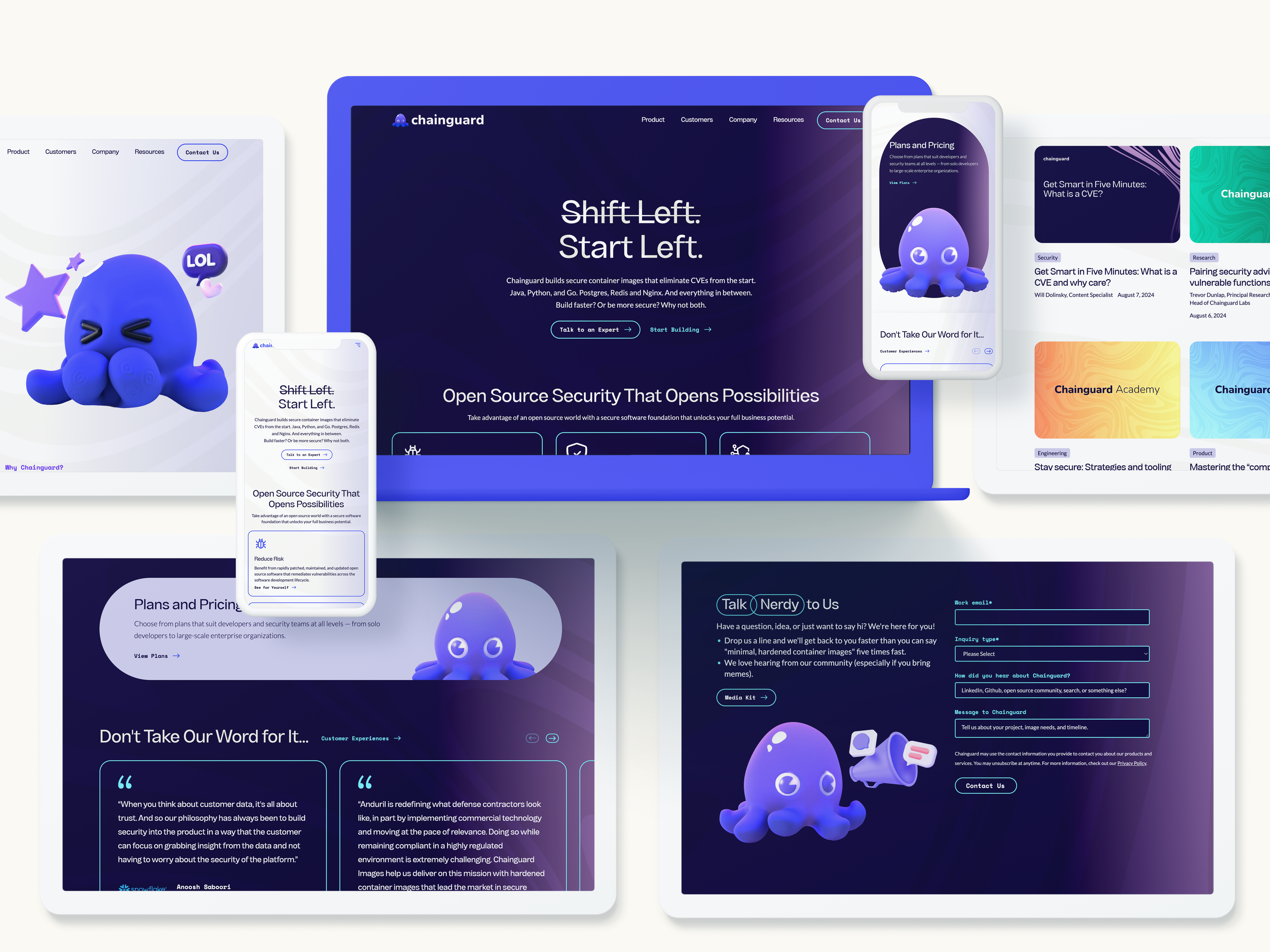
Measuring Success in B2B Influencer Campaigns
B2B sales cycles are long, complex, and rarely linear—so measuring influencer success goes beyond likes and impressions. Instead, look at:
- Engagement from the right audience segments
- Referral traffic to key landing pages or assets
- Influencer-generated content performance over time
- Assisted conversions and pipeline attribution (via UTM tracking or CRM insights)
- Brand sentiment and earned media mentions
And don’t overlook qualitative feedback: the comments, DMs, or offline conversations that signal credibility is taking root.
Influencer Marketing Is Trust Marketing
At its core, B2B influencer marketing isn’t about going viral. It’s about meeting buyers where they are, with voices they already trust. When executed strategically, it doesn’t just boost awareness—it shapes decisions, accelerates journeys, and positions your brand as a true authority within a niche.
Want to Build Your Own Influencer Ecosystem?
Bluetext helps B2B brands develop influencer strategies tailored to their vertical, audience, and goals. Whether you’re looking to launch a full-scale program or test the waters with a single campaign, we can help you activate the voices that matter.
Contact us to learn how we help brands earn trust, one niche voice at a time.
The digital marketing world is preparing for a major shift: third-party cookies are on their way out. While the writing has been on the wall for some time—thanks to growing privacy concerns, regulatory pressure, and browser-level changes—the final countdown is now in motion. For B2B marketers, this change isn’t just a technical update; it’s a signal to rethink how we connect with audiences, measure success, and build meaningful digital campaigns in a privacy-first landscape.
So what does a cookieless future really mean for B2B marketing teams? And how should companies adapt?
Why the Cookie Is Crumbling
Third-party cookies have long been the backbone of many digital marketing strategies. They’ve enabled advertisers to track user behavior across sites, build robust audience profiles, serve retargeting ads, and measure multi-touch attribution.
But between data privacy regulations (like GDPR and CCPA), increased consumer scrutiny, and decisions by major players (Google, Apple, Mozilla) to block or phase out third-party cookies, marketers can no longer depend on these trackers to deliver precision targeting.
Unlike in B2C, where massive datasets and behavioral signals are more readily available, B2B marketers often work with smaller audiences, longer buying cycles, and more complex decision-making processes. The loss of third-party cookies only heightens the need for thoughtful, compliant, and relationship-based approaches.

What’s at Stake for B2B Marketing Teams
In a post-cookie environment, several key capabilities are at risk:
- Audience targeting precision – Building lookalike or intent-based audiences becomes more difficult without access to third-party behavioral signals.
- Retargeting – Following up with anonymous site visitors through programmatic channels is less reliable or even impossible.
- Attribution tracking – Multi-channel attribution models may break down without the ability to track users across sessions and domains.
- Lead nurturing automation – Third-party data often feeds into segmentation logic for account-based and intent-driven campaigns.
This shift forces B2B marketers to re-examine how data is collected, stored, and activated—and it puts renewed emphasis on first-party data, consent, and creative execution.
Privacy-First Alternatives Built for the Future
The end of third-party cookies doesn’t mean the end of personalization or targeting—it simply requires a smarter, more ethical approach to doing so. Here’s where B2B teams should focus their attention:
1. First-Party Data Strategy
First-party data—information your audience shares directly with you—is now your most valuable asset. This includes:
- Website interactions
- CRM and sales data
- Email engagement
- Event participation
- Content downloads or form fills
Building robust lead capture mechanisms, refining gated content strategy, and aligning marketing automation with sales insights are now critical to campaign success.
2. Contextual Targeting
In a world without cookies, where an ad appears can be just as important as who sees it. Contextual targeting uses the content of a webpage to inform ad placement—think serving cybersecurity messaging on a tech policy news site. While not new, this approach has become more precise with AI and NLP advancements and is making a strong comeback in B2B media buying.
3. Identity Resolution and Clean Rooms
Platforms like LiveRamp, The Trade Desk’s UID2.0, and Google’s PAIR are offering new ways to match audiences using encrypted first-party identifiers. Meanwhile, data clean rooms allow for privacy-safe collaboration between advertisers and publishers by enabling targeting without exposing raw user data.
These solutions require careful vetting and often demand more technical investment, but they provide viable paths to compliant targeting and measurement in B2B environments.
4. Platform-Based Targeting
As third-party cookies disappear, B2B marketers will increasingly lean on platforms that control their own ecosystems—think LinkedIn, Google, Meta, and industry-specific programmatic networks. These walled gardens have deep first-party data pools and increasingly sophisticated ad tools. However, marketers must balance effectiveness with cost and limited visibility into audience behavior outside those platforms.
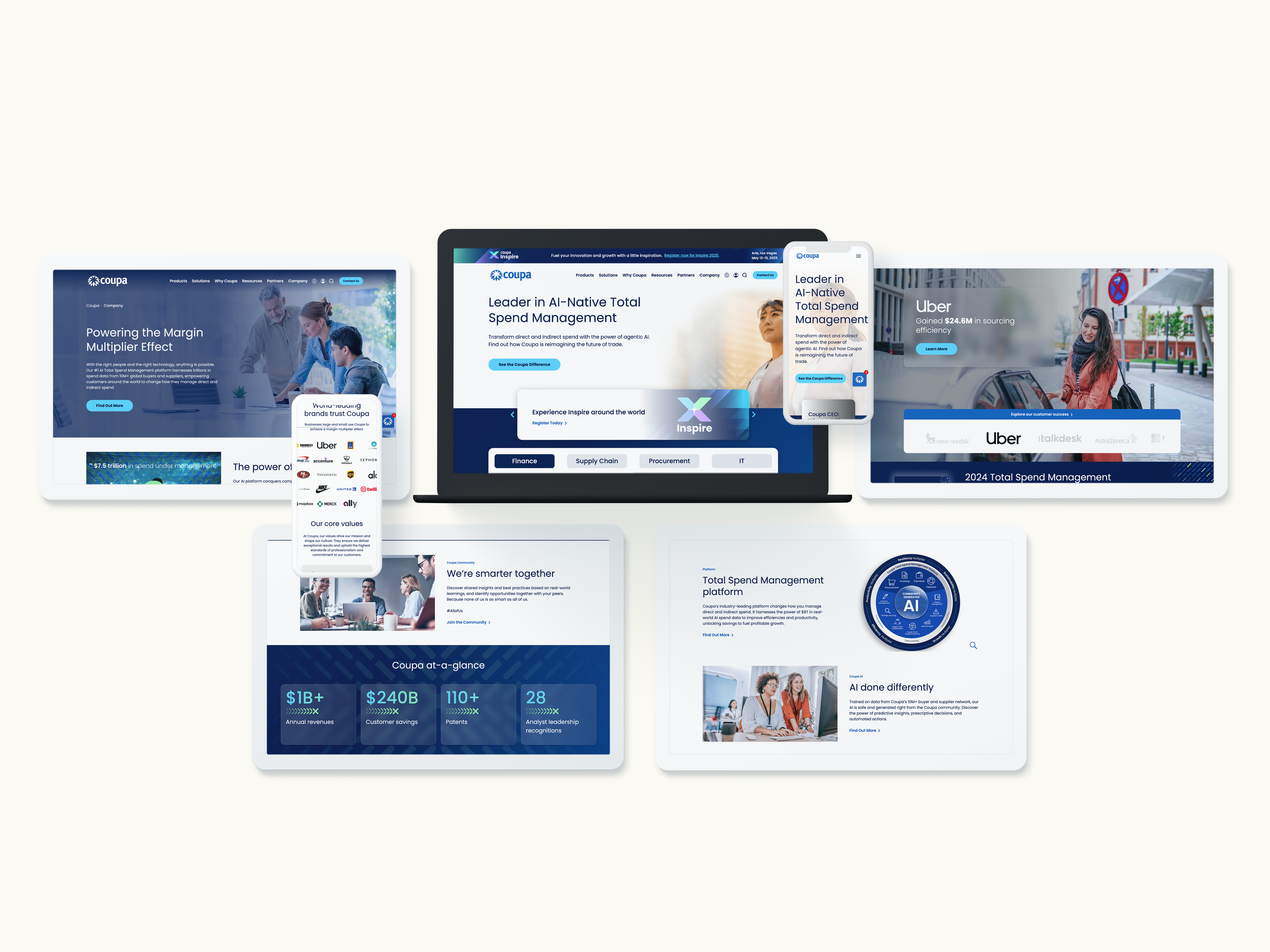
What B2B Marketers Should Be Doing Now
With the sunset of cookies no longer hypothetical, proactive planning is essential. Here are the immediate steps B2B teams should take:
- Audit your current martech stack to understand where third-party cookies are being used (from ad targeting to analytics).
- Enhance your first-party data strategy by refining lead capture forms, improving CRM hygiene, and investing in customer data platforms (CDPs).
- Test contextual and native campaigns now to build experience with post-cookie tactics.
- Explore identity solutions with your media partners and vendors to determine what options make sense for your business.
- Revisit attribution models and prepare to rely more heavily on direct engagement metrics and source-based lead reporting.
The End of Cookies Is the Start of Better Marketing
The transition away from third-party cookies is less a threat and more an opportunity—an opportunity to build deeper relationships, center strategy around consent and value, and create more resilient marketing ecosystems.
For B2B marketers, this is the time to get ahead. Waiting until third-party cookies are fully deprecated means playing catch-up in a game already in motion. The brands that win in this next phase won’t be the ones that cling to old tactics—they’ll be the ones that adapt, test, and evolve.
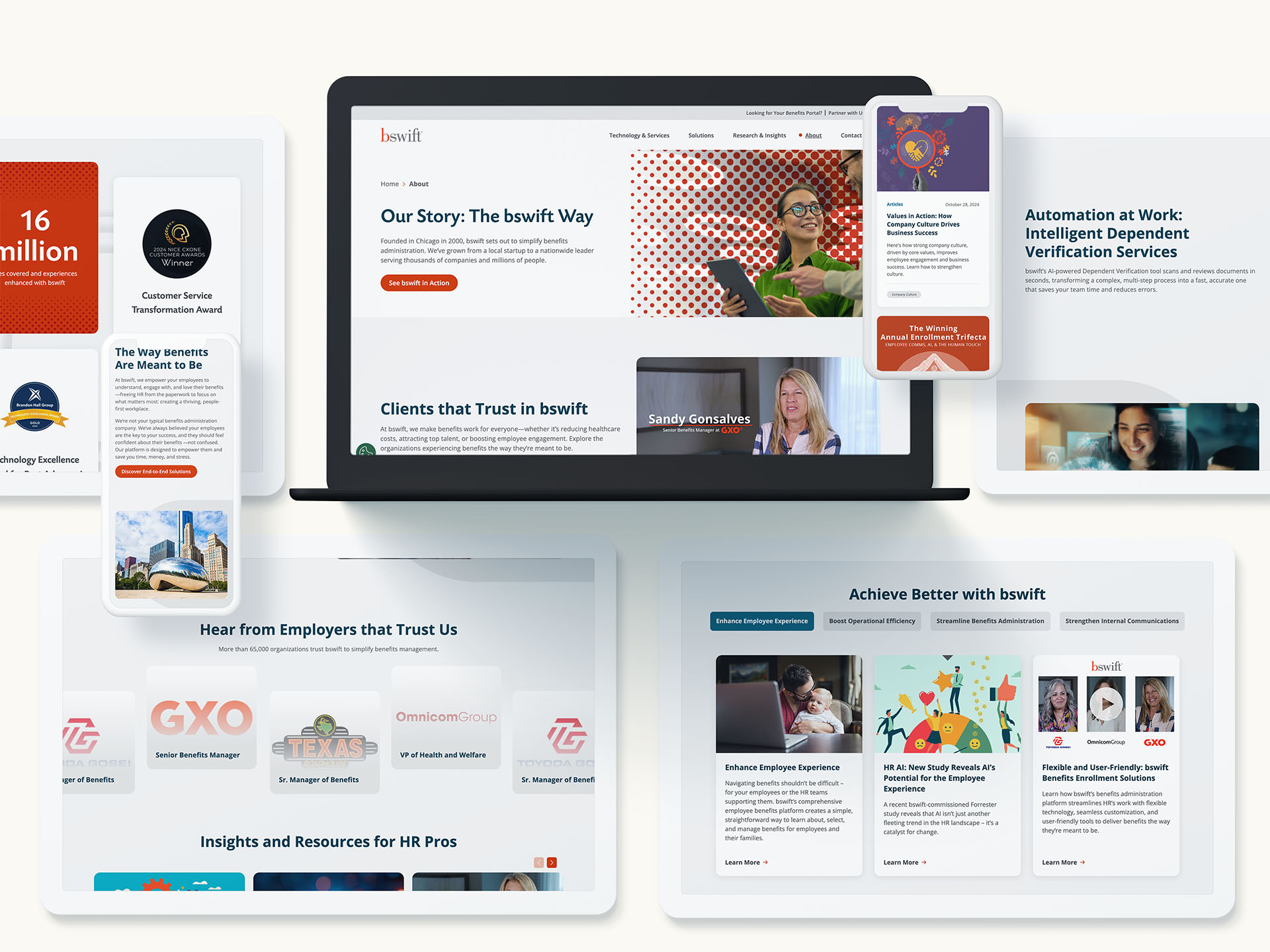
Need Help Navigating the Post-Cookie Future?
Bluetext helps B2B brands build smarter, privacy-first targeting strategies—from first-party data activation to media planning and messaging. If you’re ready to rethink your digital campaigns for the cookieless future, let’s talk.
As privacy regulations tighten, precision targeting becomes harder—here’s how to execute effective ABM without crossing data compliance lines.
The New Landscape of ABM and Data Privacy
Account-Based Marketing (ABM) has become a go-to strategy for B2B marketers aiming to deliver personalized, precise campaigns tailored to key accounts. The promise of ABM lies in its ability to engage decision-makers with highly relevant messaging and tightly focused tactics.
However, the growing wave of data privacy regulations—including GDPR in Europe, CCPA and CPRA in California, and others worldwide—is reshaping how marketers can collect, use, and share data. These laws, designed to protect consumer and business privacy, have introduced new challenges for ABM’s reliance on granular data.
In this evolving landscape, the question emerges: How can marketers maintain ABM’s effectiveness while staying fully compliant and respecting privacy? This post explores practical strategies and privacy-friendly approaches to ensure your ABM campaigns continue to deliver results without crossing data compliance lines.
The Impact of Privacy Regulations on ABM
Privacy laws place clear limits on collecting personal data without consent, restricting marketers from using many traditional data sources that ABM once depended on. The decline of third-party cookies, limitations on tracking across devices, and increased user control over data permissions have diminished marketers’ visibility into customer behaviors.
These changes affect ABM in several ways:
- Reduced access to behavioral and intent data from third-party platforms.
- Challenges in tracking individual contacts across multiple touchpoints.
- Necessity to obtain explicit consent before processing certain types of personal data.
Traditional hyper-targeted ads and behavioral retargeting tactics must be reevaluated to comply with these new realities.


Rethinking ABM Strategy for Privacy Compliance
The key to privacy-safe ABM is shifting focus towards first-party data—information collected directly from your audience through interactions they initiate and consent to.
Here are some foundational shifts marketers should make:
- Build trusted data sources: Prioritize collecting data through website forms, gated content, webinars, and events where consent is explicit.
- Consent-based marketing: Ensure all communications are compliant with opt-in and opt-out requirements.
- Quality over quantity: Instead of mass data collection, deepen insights on fewer, high-value accounts with verified data.
- Ethical standards: Embed privacy considerations into your marketing ethos to strengthen trust and brand reputation.
Privacy-Friendly Tactics to Power Effective ABM
1. Intent and Contextual Data Usage
While granular personal data becomes scarcer, marketers can harness intent signals and contextual information that do not rely on invasive tracking. For example, analyzing content engagement patterns on your site or leveraging CRM activity can provide rich insights into account interest without crossing privacy lines.
2. Enhanced CRM and CDP Integration
Customer Data Platforms (CDPs) that consolidate and manage first-party data become critical tools. They enable you to securely unify account information, track engagement consent, and enrich profiles based on direct interactions, such as demo requests or content downloads.
3. Account-Based Personalization Without Personal Data Overreach
Use firmographic data—company size, industry, location—and expressed interests to create personalized experiences. Dynamic content and A/B testing can be applied thoughtfully to tailor messaging without needing to overreach into sensitive personal data.
4. Collaboration with Legal and Compliance Teams
Privacy compliance should be a built-in component of ABM campaigns, not an afterthought. Work closely with legal and compliance experts during campaign design and maintain thorough documentation and audits to ensure ongoing adherence to regulations.


Tools and Technologies Supporting Privacy-Conscious ABM
Technology plays a pivotal role in enabling privacy-first ABM. Consider integrating:
- Privacy-first CDPs: Platforms that prioritize consent management and data security.
- Cookieless tracking solutions: Emerging tools designed to measure campaign performance without relying on third-party cookies.
- Consent management platforms (CMPs): Systems that streamline opt-in/opt-out processes and keep audit trails.
Evaluate your technology stack with privacy compliance as a core criterion to avoid risks and foster trust.
Getting Started: Implementing Privacy-Safe ABM Today
Begin your transition to privacy-conscious ABM by:
- Auditing current data collection and campaign practices for compliance gaps.
- Developing a phased roadmap to emphasize first-party data and consent.
- Training marketing and sales teams on privacy regulations and ethical marketing.
- Partnering with agencies and vendors skilled in navigating privacy requirements and agile ABM strategies.
Small, deliberate steps can help your organization adapt without disrupting momentum.
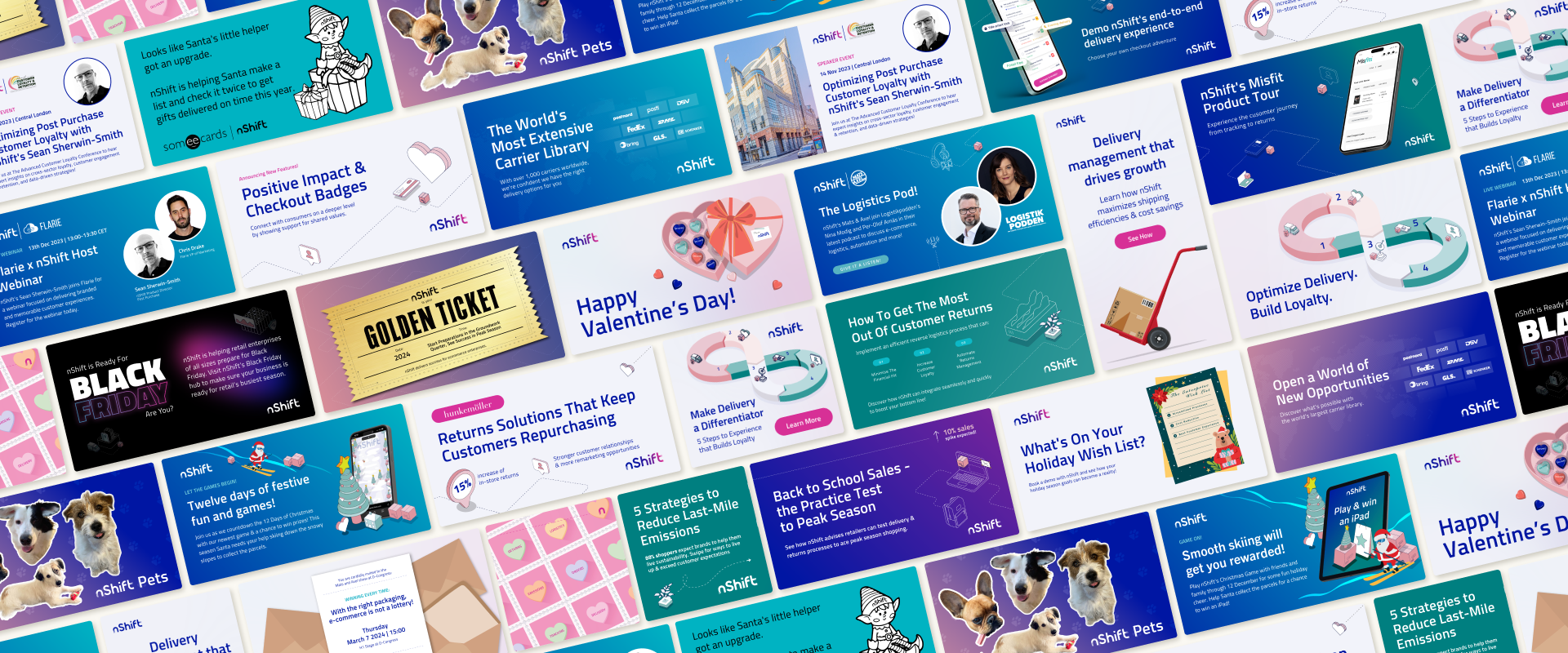


Navigating ABM Success in a Privacy-First World
Privacy regulations are not a passing trend—they represent a fundamental shift in how businesses must approach marketing. ABM remains a powerful strategy, but success now depends on transparency, respect for data, and innovative targeting methods that comply with evolving laws.
By embedding privacy as a core brand value, you not only avoid legal pitfalls but also build deeper trust with your prospects and customers, strengthening long-term relationships.
Ready to navigate ABM in the age of data privacy? Contact Bluetext to develop compliant, effective account-based strategies that drive results while respecting privacy.
Markets shift fast—your campaigns should too. Explore frameworks for adaptive marketing that keep your brand nimble and responsive.
Marketing in a World of Uncertainty
In today’s fast-paced, unpredictable market landscape, businesses face constant disruptions—whether due to economic shifts, emerging technologies, or sudden changes in consumer behavior. Traditional marketing plans, often locked in months or even years in advance, struggle to keep pace with this volatility.
To stay competitive, brands need agile marketing models—strategic frameworks that allow campaigns to flex and evolve in real time. This approach empowers marketers to respond quickly to new opportunities, pivot away from underperforming tactics, and keep their messaging relevant and impactful.
In this post, we’ll explore why traditional marketing planning often falls short, outline the principles of agile marketing, and offer practical guidance on building your own adaptive campaign framework.
Why Traditional Marketing Planning Falls Short
Conventional marketing planning typically involves long timelines, static calendars, and fixed budgets. While this approach provides structure, it leaves brands vulnerable when market conditions change unexpectedly.
Consider how disruptions like supply chain delays, platform algorithm updates, or global events can derail carefully crafted campaigns. Without flexibility, companies risk missing crucial windows of opportunity, overspending on ineffective channels, or delivering messages that no longer resonate.
The challenge: how do you keep your marketing plans relevant in an environment where everything can change overnight?



Defining Agile Marketing: Principles and Pillars
Agile marketing adapts principles from agile software development to create a more responsive, iterative approach to campaign planning and execution. Key pillars include:
- Test-and-learn mindset: Launch small experiments, measure results, and refine tactics continuously.
- Cross-functional sprints: Work in short cycles, often 2–4 weeks, allowing teams to focus on manageable goals and rapidly adjust course.
- Modular content creation: Build reusable assets and messaging components that can be quickly swapped or updated.
- Rapid feedback loops: Collect real-time data and customer insights to inform decision-making.
- Real-time analytics integration: Use performance dashboards and tools to monitor campaigns and identify pivot points early.
This contrasts with traditional “waterfall” marketing, which typically follows a linear sequence and resists change once the plan is set.


Building an Agile Campaign Framework
Here’s how to put agile marketing into practice with a flexible campaign model:
1. Modular Messaging and Content
Create content in “blocks” or modules—such as headlines, visuals, CTAs—that can be mixed and matched depending on the moment. This makes it easier to tailor messages on the fly for different audiences, channels, or cultural moments without starting from scratch.
2. Short Sprints and Iterative Launches
Instead of committing to an entire campaign upfront, plan in short bursts (sprints). Launch a minimum viable campaign quickly, then use data and feedback to optimize each sprint. This lets you capitalize on new trends or pause investments in low-performing areas promptly.
3. Decision-Making with Live Data
Integrate tools like Google Analytics 4, HubSpot, or Looker to track campaign KPIs in real time. Set clear thresholds that trigger reviews and adjustments. The faster you can access insights, the faster your team can pivot tactics or messaging.
4. Team Agility and Cross-Functional Collaboration
Agile marketing requires breaking down silos. Build small, empowered teams combining creative, data, media, and strategy experts who can make decisions collaboratively and quickly. This removes bottlenecks and speeds up execution.
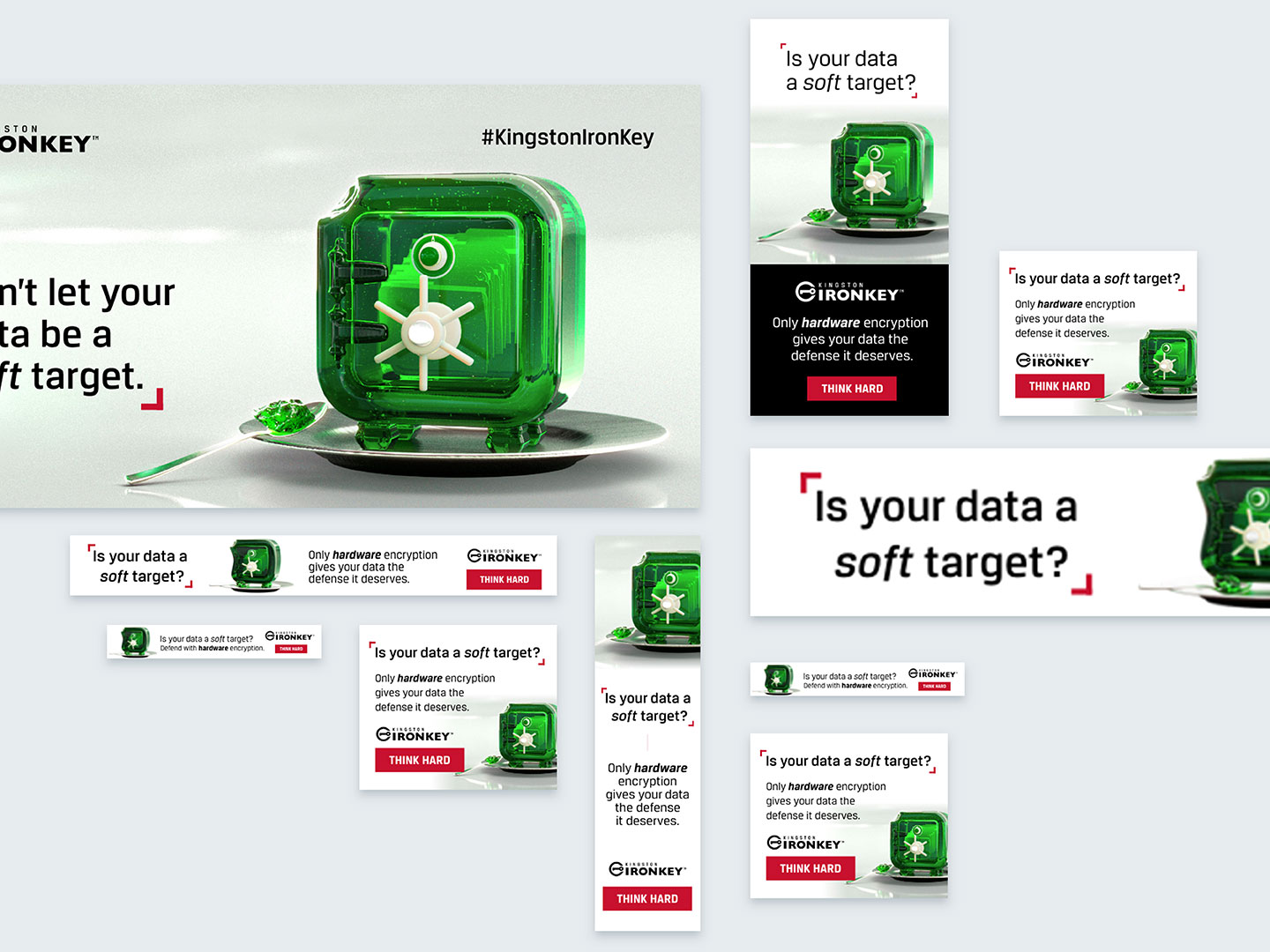

How to Start: Transitioning to Agile Without Overhauling Everything
You don’t have to rebuild your entire marketing operation overnight. Begin with a pilot project—choose a single campaign or product launch to test agile methods.
Invest in agile-friendly tools and workflows, such as project management platforms that support sprints and collaboration. Share early wins and learnings to build momentum internally.
Finally, consider partnering with an agency experienced in agile marketing to guide your transition and help scale your efforts efficiently.
Future-Proofing Your Marketing Strategy
Agility isn’t just a buzzword—it’s a necessity in today’s uncertain world. Brands that embrace flexible, adaptive marketing strategies will outmaneuver competitors stuck in rigid planning cycles.
By designing campaigns that are built to pivot, you can transform uncertainty into a competitive advantage.
Ready to make your marketing more agile? Connect with Bluetext to build flexible frameworks that evolve alongside your business.
When most marketers think of SMS, they picture retail alerts, flash sales, or appointment reminders—tactics firmly planted in the B2C world. But dismissing SMS as irrelevant for B2B is a missed opportunity. In reality, text messaging can be one of the most direct, high-impact tools in your B2B marketing arsenal—if you know when and how to use it.
In an era where inboxes are overloaded and attention spans are shrinking, SMS offers a rare advantage: it gets read. Studies show SMS open rates hover around 98%, and response rates can be as high as 45%. For comparison, email sits around 20% and 6%, respectively. That’s a significant gap—and one B2B marketers can no longer afford to ignore.
Why SMS Is Overlooked in B2B (and Why That’s Changing)
Historically, SMS has been seen as too casual or invasive for the B2B space. Enterprise buyers aren’t browsing for deals via text—they’re making complex, considered decisions. But the idea that professional communication has to be long-form or confined to email is quickly becoming outdated.
As the lines between work and personal life continue to blur, decision-makers are relying more on mobile to stay productive. That means a well-timed, relevant SMS can cut through the noise—especially when it’s part of a thoughtful, omnichannel approach.
Compliance concerns have also contributed to hesitation around SMS, but platforms have evolved. Today’s SMS tools for B2B are built to meet regulatory standards, offering opt-in workflows, tracking, and integrations with your existing CRM.


When SMS Makes Sense in B2B Campaigns
The key to effective B2B SMS marketing is knowing when to use it—and when to hold back. SMS isn’t a channel for every message. But in the right context, it can serve as the perfect nudge.
Here are some strategic use cases:
- High-intent lead follow-up: A quick text to confirm a meeting or thank a prospect for attending a demo can accelerate the sales cycle.
- Event and webinar reminders: SMS ensures higher attendance rates with last-minute nudges, especially for executive-level registrants.
- Account-based marketing (ABM) touchpoints: Personalized messages to high-value accounts help reinforce relationships and drive action.
- Urgent alerts or updates: Whether it’s a product release or contract deadline, time-sensitive information is better received via text than email.
- Post-sale engagement: For customer success teams, SMS can be a valuable tool for onboarding, check-ins, or renewal reminders.
How to Use SMS in B2B the Right Way
Just because you can text your prospects doesn’t mean you should do it without a plan. B2B SMS marketing works best when it’s strategic, respectful, and fully integrated into your broader campaigns.
Here’s how to get it right:
- Obtain explicit consent: Always use opt-in forms and make it easy to opt out. Respect for privacy builds trust.
- Keep it short and useful: SMS isn’t the place for fluff. Messages should be concise, relevant, and action-oriented.
- Personalize your outreach: Use first names, company names, or reference a specific meeting or download to show it’s not a generic blast.
- Integrate with your tech stack: Connect your SMS tool to your CRM and marketing automation platforms to sync messages, track performance, and trigger texts based on user behavior.
- Test and optimize: Run A/B tests on timing, copy, and CTA to learn what resonates—and avoid message fatigue.
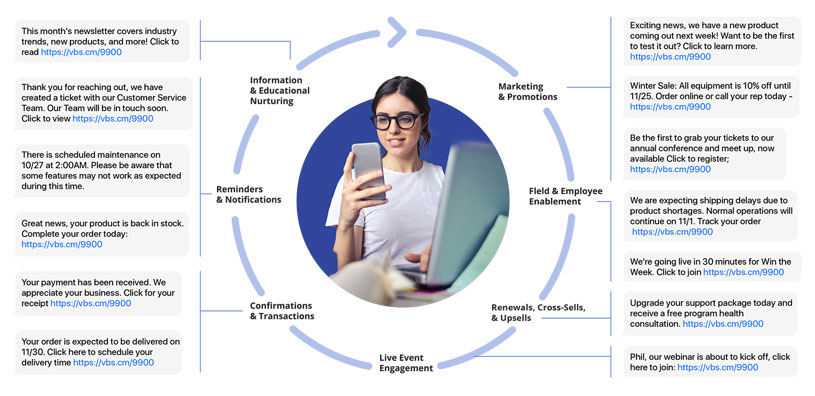

SMS as Part of an Omnichannel B2B Strategy
The real power of SMS lies in how it supports and enhances your existing marketing channels. Think of it as the connective tissue between your emails, digital ads, webinars, and sales outreach.
For example:
- Follow up a gated content download with an email, then a personalized text offering a meeting.
- Send an SMS reminder the day before a webinar, with the Zoom link included.
- After a conference, send a thank-you text from the sales rep who spoke with the lead, offering a quick call.
When done right, SMS doesn’t disrupt the buyer journey—it smooths it out.
The Takeaway
SMS is no longer just for B2C brands or retail promotions. In today’s mobile-first world, B2B buyers are just as reachable via text—and often more responsive. The key is using SMS intentionally, at high-value moments, and as part of a cohesive omnichannel strategy.
Whether you’re nurturing leads, boosting event attendance, or keeping key accounts engaged, SMS offers a direct, powerful line of communication that few other channels can match.
Ready to elevate your B2B marketing strategy with SMS?
Let’s build a smarter, more connected campaign—contact Bluetext today to get started.
For years, headless CMS platforms have been the go-to solution for brands seeking flexibility, speed, and scalability in their digital content delivery. By decoupling the front end from the back end, headless architecture empowered marketers and developers to create omnichannel experiences with greater efficiency. But as user expectations grow more sophisticated and digital ecosystems become more complex, even headless is starting to show its limits.
So what’s next? The future of content management isn’t just about removing the head—it’s about building a smarter, more adaptable brain. From composable digital experience platforms to AI-driven personalization engines, the next generation of CMS technology is poised to transform how organizations structure, deliver, and optimize content.
Here’s what’s on the horizon.
Composable Architecture: Breaking Down the Monolith for Good
If headless CMS decoupled the front end from the back end, composable architecture takes things a step further—decoupling everything. A composable digital experience platform (DXP) allows organizations to assemble a custom stack of best-of-breed tools for CMS, e-commerce, personalization, analytics, and more, all connected via APIs.
The result? Greater agility. Marketers and IT teams are no longer boxed into rigid, one-size-fits-all platforms. Instead, they can mix and match services that best support their goals—whether that’s fast localization, dynamic pricing, or seamless omnichannel orchestration. Composable architecture also allows for incremental upgrades, so brands can evolve their digital presence without overhauling entire systems.


AI-Powered Content Delivery Is Here—and Growing Fast
AI is no longer a buzzword in CMS. It’s becoming the engine behind smarter content experiences. From predicting what content a user will find most valuable, to dynamically adjusting layouts based on behavior, AI is changing the way brands think about digital engagement.
Modern CMS platforms are beginning to integrate AI-driven features like:
- Content recommendations based on user behavior and intent
- Automated tagging and metadata generation for better asset management
- Real-time personalization, delivering tailored content to the right audience at the right time
By embedding AI into the content supply chain, brands can move beyond static publishing toward experiences that are predictive, personalized, and performance-driven.


Content Operations Are Getting an Overhaul
The CMS of the future doesn’t just manage content—it powers an entire ecosystem of digital operations. That means tighter integration with Digital Asset Management (DAM) platforms, Customer Data Platforms (CDPs), and marketing automation tools.
Content teams are shifting away from traditional editorial calendars and rigid workflows. Instead, they’re embracing:
- Structured content models that support reusability across channels
- Data-informed content strategies based on performance insights
- Collaborative environments where marketers, designers, and developers work in sync
This new model of Content Ops is about more than publishing—it’s about treating content as a living asset that evolves and adapts to user needs.
API-First, Cloud-Native Platforms Are the New Standard
As organizations grow more complex and global, performance and scalability are critical. That’s where API-first, cloud-native CMS solutions come in. Built for integration and extensibility, these platforms allow developers to plug into virtually any system—without being locked into a vendor’s proprietary tools or workflows.
Benefits of API-first CMS platforms include:
- Faster development and deployment cycles
- Seamless integration with existing martech and eCommerce platforms
- Improved security, scalability, and reliability through modern cloud infrastructure
For enterprise brands navigating multi-site, multilingual, or multi-channel challenges, API-first CMS solutions offer the flexibility to deliver consistent, high-performance experiences across the board.
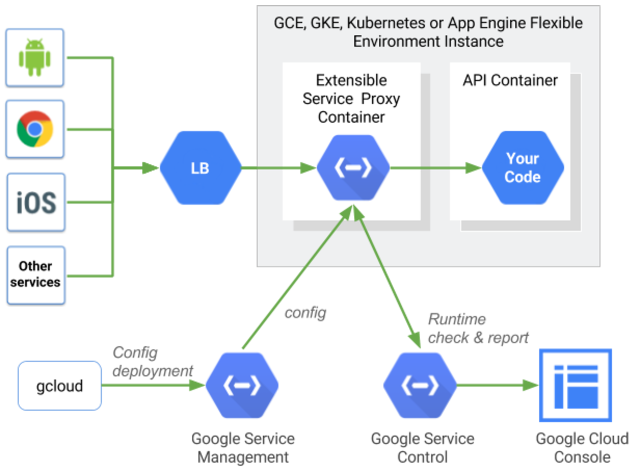

So, What Should Brands Do Now?
If your organization is currently running a traditional CMS—or even a headless one—it’s time to look ahead. The CMS landscape is evolving rapidly, and the platforms of tomorrow will be defined by their intelligence, adaptability, and interoperability.
Key considerations as you plan for the future:
- Audit your current content ecosystem: What tools are in place, and where are the bottlenecks?
- Invest in modular, composable architecture: Future-proof your stack by prioritizing flexibility and integration.
- Explore AI capabilities: Start with features like smart recommendations or auto-tagging, and scale up as you see results.
- Think beyond websites: Your CMS should support a unified experience across mobile, social, voice, and more.
At Bluetext, we help organizations reimagine their digital infrastructure to support not just where they are—but where they’re going.
Ready to evolve your CMS strategy?
Contact Bluetext to architect a future-ready content platform that’s intelligent, scalable, and built to grow with your brand.
When marketers think of social media for B2B, the usual suspects come to mind—LinkedIn, X (formerly Twitter), and maybe YouTube. Reddit? It’s often written off as the Wild West of the internet: chaotic, anonymous, and unpredictable. But for those willing to navigate its nuances, Reddit can be a goldmine of insight, authenticity, and B2B engagement.
Reddit isn’t just cat memes and AMAs from celebrities. It’s a thriving ecosystem of professionals, buyers, engineers, and decision-makers asking questions, solving problems, and sharing unfiltered opinions. For B2B marketers, that’s an opportunity you can’t afford to ignore—so long as you approach it the right way.
Why Reddit Deserves a Spot in Your B2B Strategy
Reddit is the sixth most-visited site in the U.S., boasting over 1.7 billion visits per month. What sets it apart isn’t just the scale—it’s the structure. Reddit is divided into thousands of interest-based communities (called subreddits), each with its own culture, norms, and moderators.
This makes Reddit less like a traditional social media platform and more like a decentralized forum. The conversations are honest, often brutally so, and the self-promotion police are always watching. That’s why marketers need to rethink their playbook here.
But when used smartly, Reddit offers three powerful advantages for B2B brands:
- Direct access to niche professional communities
- Real-time market intelligence and customer pain points
- Opportunities for thought leadership in high-trust environments
Reddit vs. Other Platforms: A Different Set of Rules
On Reddit, trust is everything—and users are quick to call out anything that feels like a sales pitch. Unlike algorithm-driven platforms that reward virality, Reddit rewards value. This value usually comes in the form of helpful answers, shared experiences, or genuine discussion.
A few things that make Reddit unique:
- Anonymity encourages honesty
- Users upvote/downvote posts based on value, not popularity
- Each subreddit has its own rules—many ban self-promotion outright
- Engagement is conversation-first, not content-first
In short, you’re not talking at your audience—you’re talking with them.
Where B2B Conversations Are Happening on Reddit
You might be surprised by the depth of professional discussions taking place on Reddit. Whether it’s an IT admin trying to solve a security issue, a founder exploring pricing models, or a marketer testing messaging—Reddit is where professionals go to speak candidly.
Here are a few subreddits worth exploring:
- r/sysadmin – IT infrastructure, troubleshooting, and vendor comparisons
- r/AskEngineers – Engineering insights and technical questions
- r/smallbusiness – Entrepreneurial advice and SaaS tool recommendations
- r/marketing – Strategy, channels, and campaign reviews
- r/legaladvice – Regulatory and compliance discussion (especially useful for legal tech and fintech marketers)
These forums are treasure troves for social listening, offering unfiltered insights into what your target audience actually thinks—and what keeps them up at night.
How to Engage Authentically (And Avoid Getting Downvoted)
Reddit is not the place for traditional brand marketing. Come in too strong, and you’ll get downvoted—or worse, banned. Here’s how to participate without blowing your cover:
✅ Listen Before You Speak
Lurk in relevant subreddits. Track recurring questions. Identify influencers. Get a feel for how your target users communicate and what matters to them.
✅ Be Helpful, Not Promotional
Reddit users respond best to transparency and expertise. If you’re going to comment or post, make sure it adds real value—think troubleshooting advice, experience-based responses, or resource recommendations.
✅ Post as a Person, Not a Brand
Unless you’re hosting an official AMA (Ask Me Anything), it’s better to comment as an individual professional. You’ll build trust more easily that way.
✅ Use Reddit Ads to Test the Waters
Reddit’s paid ad platform allows brands to place content in specific subreddits with high precision. While the organic path takes time, promoted posts can be a safe entry point for testing messaging or driving traffic.
✅ Follow the Rules (Really)
Each subreddit has its own guidelines. Some ban promotional links, others require flairs or minimum karma. Break the rules, and you’re out. Respect the community if you want to stay in it.
Reddit Use Cases for B2B Brands
Done right, Reddit can amplify your marketing efforts:
- Thought Leadership: Host AMAs with product managers, engineers, or subject matter experts
- Product Feedback: Monitor mentions of your product or competitors for unfiltered reviews
- Persona Development: Use real conversations to refine audience personas and messaging
- Content Ideation: Discover trending questions and topics to fuel your blog, SEO, or video content
- Support and Reputation Management: Address concerns in real time or redirect users to support channels
Avoid These Common Reddit Marketing Mistakes
Reddit can be unforgiving. Here’s what to avoid:
- ❌ Posting links without context or commentary
- ❌ Copy-pasting marketing content into threads
- ❌ Creating throwaway accounts just for brand activity
- ❌ Ignoring subreddit rules
- ❌ Being defensive when challenged
If your engagement isn’t authentic, it won’t work—and it could do more harm than good.
Reddit Is a Risk—But a Smart One
Reddit isn’t a plug-and-play platform. It requires research, patience, and a light touch. But for B2B marketers seeking more meaningful engagement and market insight, the upside is huge. It’s one of the few digital spaces where people say what they really think—and if you can navigate it right, your brand can benefit from that raw authenticity.
At Bluetext, we help B2B brands explore emerging digital channels like Reddit with the right strategy, tone, and content to drive real results.
Looking to tap into new communities and platforms? Contact Bluetext to build a social strategy that goes beyond the expected.
As 5G networks continue to roll out globally, marketers are beginning to tap into a new frontier of possibility. Faster speeds, ultra-low latency, and increased connectivity don’t just mean better streaming—they open the door to experiences that were previously unimaginable.
From immersive augmented reality to real-time personalization, 5G marketing is poised to redefine how brands engage with audiences. The question isn’t whether marketers should prepare for 5G, but how they’ll take advantage of it.
What Makes 5G Different?
To understand the power of 5G, think beyond speed. Yes, it’s significantly faster than 4G—but the real magic lies in ultra-low latency (the delay between action and response) and massive device connectivity. That means:
- Live experiences with virtually no lag
- Real-time data streaming and decision-making
- Simultaneous connections to thousands of devices per square mile
For marketers, these capabilities unlock creative formats and technologies that previously felt too bulky, slow, or impractical for real-world deployment.
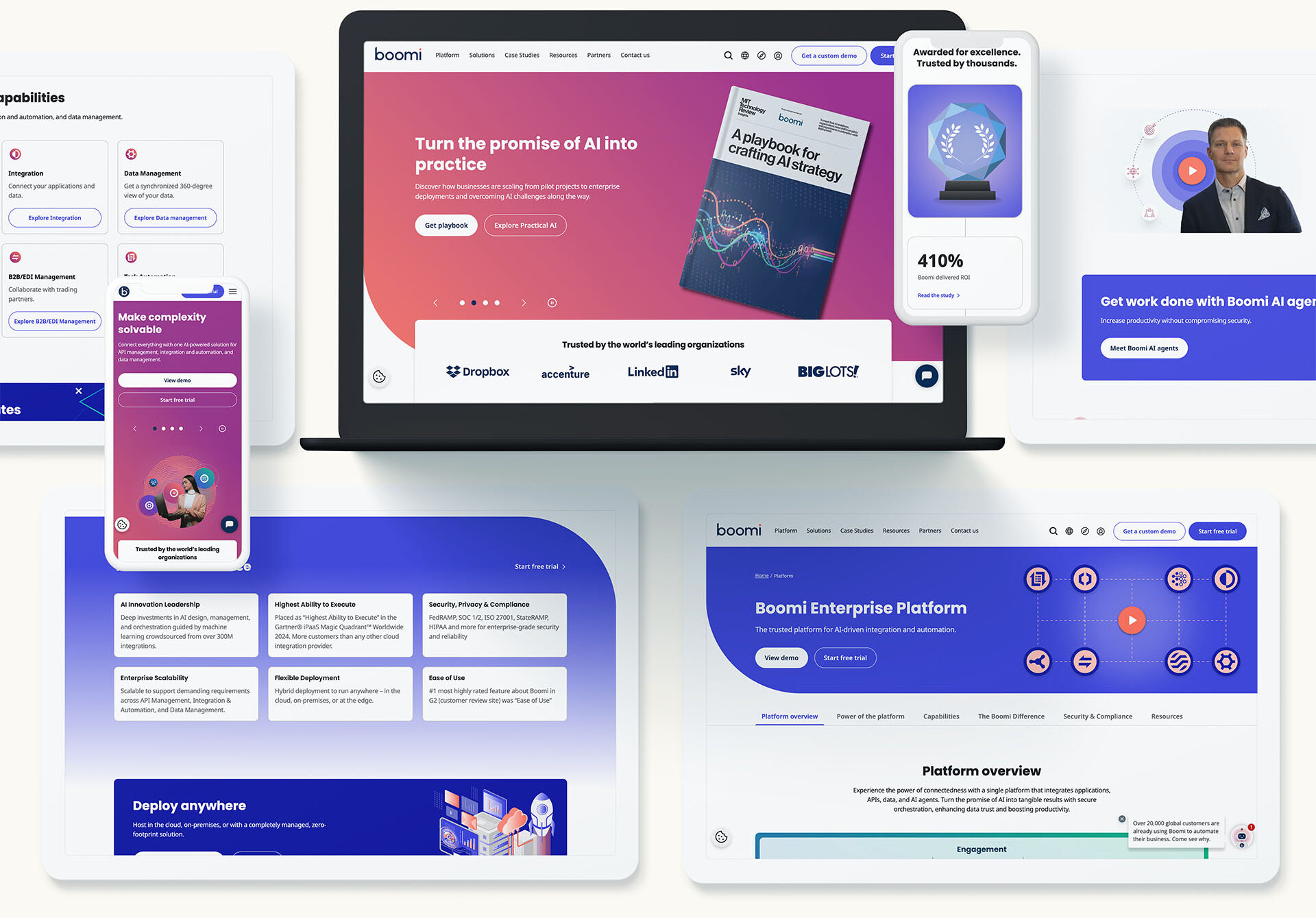

New Formats Enabled by 5G Marketing
The shift to 5G isn’t just technical—it’s creative. Here are some of the most exciting ways brands can capitalize on the format flexibility and performance of 5G:
1. Immersive AR and VR Experiences
Whether it’s a virtual showroom, branded lens, or interactive training simulation, 5G removes the friction from immersive tech. With faster loading times and real-time rendering, brands can offer AR/VR activations that feel seamless and deeply engaging—without needing users to be tethered to high-end devices.
2. Interactive Live Streams
Forget one-way livestreams. With 5G, brands can create multi-camera events, live Q&As, or choose-your-own-adventure-style broadcasts where users interact in real time. This is particularly compelling for entertainment, retail, and sports marketing.
3. Smarter Digital Out-of-Home (DOOH)
Billboards and signage are getting smarter. Thanks to 5G, dynamic DOOH ads can be updated in real time, personalized based on audience data, or made interactive via mobile engagement. Think geofenced ads that respond to foot traffic or weather conditions.
4. Real-Time Personalization at Scale
With lightning-fast connectivity and edge computing, marketers can deliver customized content in the moment—whether it’s a product recommendation, pricing adjustment, or localized offer. This could make personalization feel less like automation and more like true 1:1 engagement.



Real-World Campaign Ideas to Inspire
- A sneaker brand could launch an AR scavenger hunt across a city, with real-time rewards delivered as users complete challenges.
- A B2B tech company might host a virtual product demo where attendees can explore features in 3D and chat live with sales reps—all from their phones.
- A luxury auto brand could livestream a vehicle launch with multiple perspectives and allow viewers to control the camera angles in real time.
With 5G marketing, these ideas are no longer pipe dreams—they’re pilot-ready.
What Are the Challenges?
Of course, innovation comes with trade-offs. Some limitations to keep in mind:
- 5G network availability is still uneven, especially in rural areas.
- Creative production for immersive formats can be resource-intensive and requires specialized teams or partners.
- Not every user will be equipped with 5G-compatible devices—yet. Marketers must balance bleeding-edge experiences with accessibility and reach.
That said, adoption is accelerating, and preparing now ensures your brand isn’t playing catch-up when the tipping point arrives.
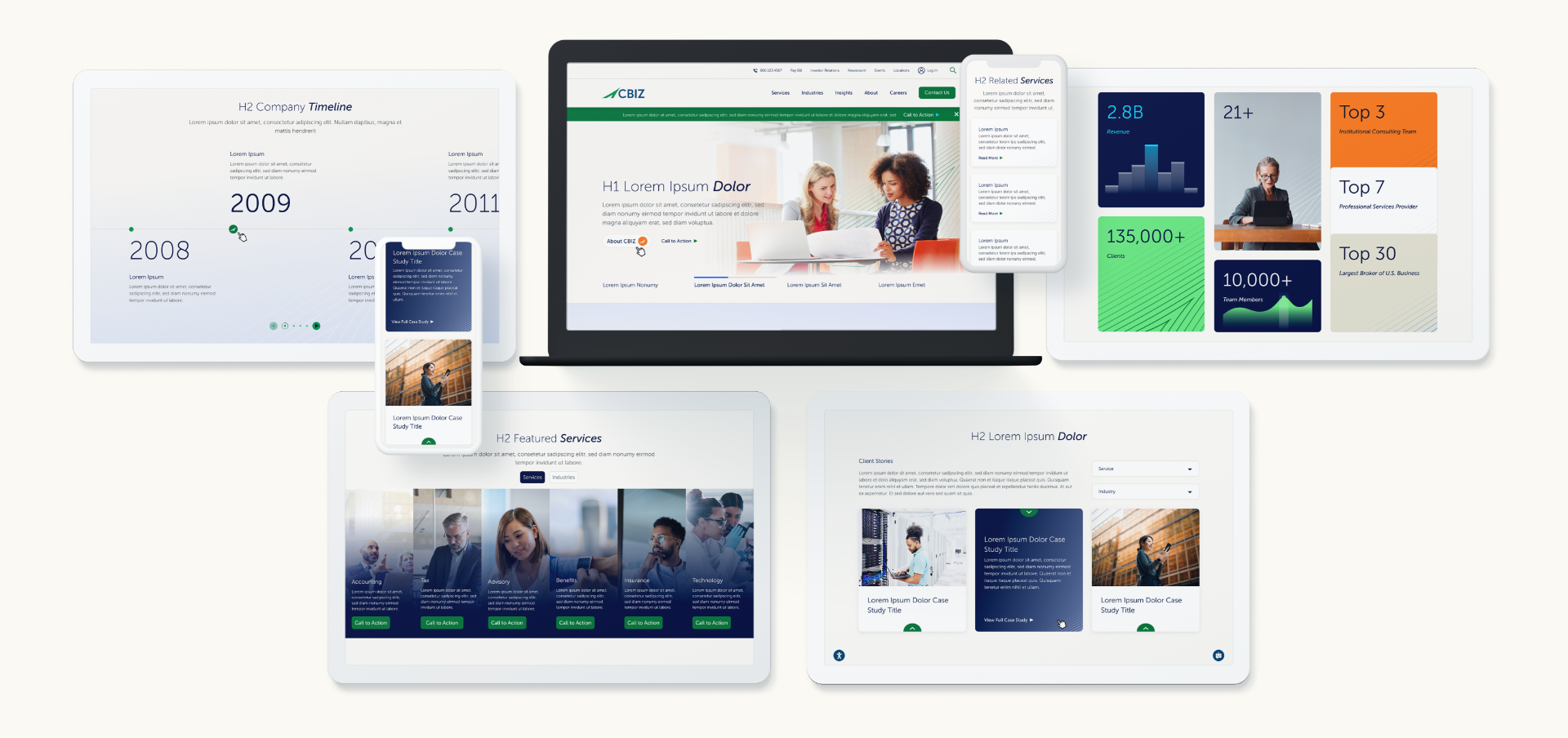


How to Get Ready for 5G Marketing
The transition to 5G isn’t something marketers need to wait for—it’s something they can build toward today. Here’s how to get started:
Invest in Flexible, Modular Content
Create content that can be reused and reassembled across formats—2D, 3D, AR, live video, etc. This sets you up to adapt quickly to evolving platforms and technologies.
Experiment with Immersive Storytelling
Start small with pilot campaigns that use basic AR filters, shoppable livestreams, or interactive mobile experiences. This builds your team’s capabilities and provides data to inform larger efforts.
Prioritize Strategic Partnerships
Work with agencies, tech providers, and platforms that are already integrating 5G-ready infrastructure. You don’t have to go it alone—collaboration is key in this new landscape.
Marketing at 5G Speed: Are You Ready?
5G isn’t just a telecom upgrade—it’s a creative unlock. For brands willing to explore its possibilities, it offers a chance to engage audiences in richer, faster, more meaningful ways than ever before.
Whether you’re launching immersive content, building personalized real-time journeys, or experimenting with smart environments, 5G marketing is where storytelling meets speed.
At Bluetext, we help forward-thinking brands push the boundaries of digital engagement. If you’re ready to explore what 5G could mean for your marketing strategy, contact us—we’re already thinking about what comes next.
In today’s business landscape, mergers, acquisitions, and IPOs aren’t just transactions—they’re strategic leaps. Whether it’s a defense contractor expanding its mission set, a fintech firm going public to scale, or a cybersecurity company consolidating talent and tech, every move tells a story about where an industry is headed.
At Bluetext, we help organizations position themselves for these defining moments. That’s why we took a closer look at 82 notable transactions—each of which occurred within 24 months following a Bluetext engagement. From landmark deals like VMware’s acquisition by Broadcom to precision plays like CyberArk’s IPO and Culmen Technologies’ acquisition of PlanetRisk Federal—to understand the trends shaping the business world in 2025.
In this comprehensive overview, we delve into 82 significant transactions that have shaped various industries. Each transaction is accompanied by a concise summary and an analysis of the strategic advantages of the merger, IPO, or acquisition.
1. Reznick Group Acquired by CohnReznick
Summary: CohnReznick’s acquisition of Resnick Group strengthened its position in the accounting and advisory sector, enhancing service offerings and expanding its client base.
Strategic Advantage: This merger enabled CohnReznick to achieve economies of scale, streamline operations, and offer a broader range of services to clients, thereby increasing market share and competitiveness.
2. SourceFire Acquired by Cisco
Summary: Cisco’s acquisition of cybersecurity firm SourceFire for $2.7 billion in 2013 bolstered its security portfolio, integrating advanced threat protection solutions.
Strategic Advantage: The acquisition allowed Cisco to enhance its cybersecurity offerings, providing comprehensive protection solutions and addressing the growing demand for advanced threat defense mechanisms.
3. CyberArk Goes Public on NASDAQ
Summary: CyberArk, a pioneer in privileged access management (PAM), made its debut on the NASDAQ stock exchange, marking a major milestone in the evolution of enterprise cybersecurity. As one of the first cybersecurity firms focused solely on identity security to go public, CyberArk’s IPO signals increasing investor interest in solutions that protect against insider threats and credential-based attacks—two of the most pervasive risks in today’s digital landscape.
Strategic Advantage: Going public gives CyberArk the capital and visibility to accelerate its growth in a crowded identity security market. As organizations face mounting pressure to secure hybrid environments and zero trust frameworks, CyberArk’s PAM solutions are uniquely positioned to meet the moment.


4. HelloWallet Acquired by Morningstar
Summary: Morningstar’s acquisition of HelloWallet, a personal finance software company, expanded its financial wellness offerings, providing comprehensive tools for individual financial planning.
Strategic Advantage: This acquisition diversified Morningstar’s product portfolio, allowing it to cater to a broader customer base seeking integrated financial planning and investment solutions.
5. Riverbed Acquired by Thoma Bravo
Summary: Private equity firm Thoma Bravo acquired Riverbed Technology, a leader in application performance infrastructure, aiming to drive innovation and growth in network optimization solutions.
Strategic Advantage: The acquisition provided Thoma Bravo with a robust platform in the network performance sector, enabling synergies that could lead to enhanced product offerings and market expansion.
6. Acentia Acquired by Maximus
Summary: Maximus acquired Acentia, a provider of technology and management solutions, to enhance its capabilities in serving federal health and civilian agencies.
Strategic Advantage: This merger expanded Maximus’s service offerings in the government sector, allowing for a more comprehensive approach to IT and management solutions for federal clients.
7. Altimeter Acquired by Prophet
Summary: Prophet’s acquisition of Altimeter Group, a research and advisory firm, strengthened its digital transformation consulting services, offering deeper insights into emerging technologies.
Strategic Advantage: Integrating Altimeter’s expertise allowed Prophet to provide clients with cutting-edge strategies in digital transformation, enhancing its competitive edge in the consulting industry.
8. Abaco Systems Acquired by Veritas Capital
Summary: Veritas Capital acquired Abaco Systems, a provider of embedded computing solutions, to expand its portfolio in defense and industrial markets.
Strategic Advantage: The acquisition enabled Veritas to diversify its holdings and strengthen its presence in high-growth sectors, leveraging Abaco’s established relationships and technological capabilities.
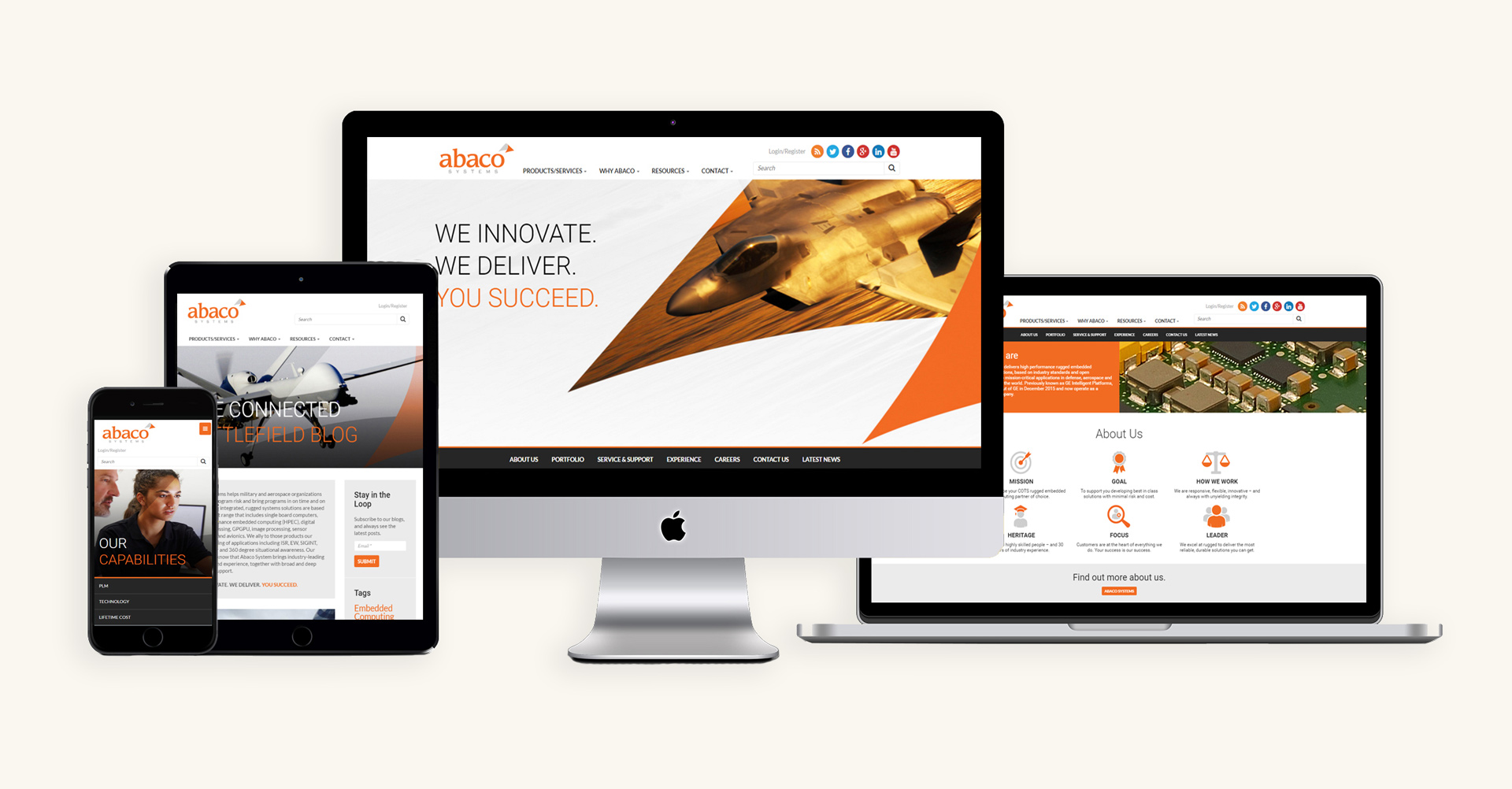

9. Force3 Acquired by Sirius
Summary: Sirius Computer Solutions acquired Force3, enhancing its networking and security solutions offerings for federal agencies.
Strategic Advantage: This merger allowed Sirius to broaden its federal market footprint, providing comprehensive IT solutions and capitalizing on Force3’s established government contracts.
10. Cigital Acquired by Synopsys
Summary: Synopsys acquired Cigital, a software security firm, to bolster its software integrity portfolio, providing comprehensive application security solutions.
Strategic Advantage: The acquisition strengthened Synopsys’s position in the software security market, enabling it to offer end-to-end solutions that address the increasing demand for secure software development.
11. Perthera Acquired by Pilot Growth
Summary: Pilot Growth Equity invested in Perthera, a precision medicine company, to accelerate its development of personalized cancer treatment solutions.
Strategic Advantage: This investment provided Perthera with the necessary capital to advance its innovative cancer treatment technologies, positioning it as a leader in the rapidly evolving precision medicine field.
12. CSC Merged into DXC
Summary: The merger of Computer Sciences Corporation (CSC) and the Enterprise Services business of Hewlett Packard Enterprise formed DXC Technology, a global IT services leader.
Strategic Advantage: The formation of DXC Technology created a powerhouse in IT services, combining resources and expertise to offer a comprehensive range of solutions to clients worldwide.
13. CB&I Acquired by Veritas Capital
Summary: Veritas Capital acquired the Capital Services business of CB&I, enhancing its portfolio in government services and infrastructure.
Strategic Advantage: This acquisition allowed Veritas to expand its offerings in the government sector, leveraging CB&I’s established infrastructure projects and client relationships.
14. Sage Acquired by GTCR
Summary: Private equity firm GTCR acquired Sage Payment Solutions, aiming to expand its presence in the payment processing industry.
Strategic Advantage: The acquisition provided GTCR with a platform to capitalize on the growing electronic payments market, leveraging Sage’s technology and customer base.
15. NetWatcher Acquired by Qualys
Summary: Qualys acquired NetWatcher, a provider of network security solutions, to enhance its cloud-based security and compliance offerings.
Strategic Advantage: Integrating NetWatcher’s capabilities allowed Qualys to offer more robust and comprehensive security solutions, addressing the increasing demand for cloud security.
16. XO Communications Acquired by Verizon
Summary: Verizon acquired XO Communications, expanding its fiber-optic network and enhancing its enterprise service capabilities.
Strategic Advantage: The acquisition strengthened Verizon’s infrastructure, enabling it to offer improved services to enterprise customers and support the growing demand for high-speed connectivity.
17. Endgame Acquired by Accenture Federal Services
Summary: Accenture Federal Services acquired Endgame, a cybersecurity firm specializing in endpoint protection, to bolster its security offerings for government clients.
Strategic Advantage: This acquisition enhanced Accenture’s ability to provide advanced cybersecurity solutions, addressing the critical needs of federal agencies in protecting against evolving cyber threats.
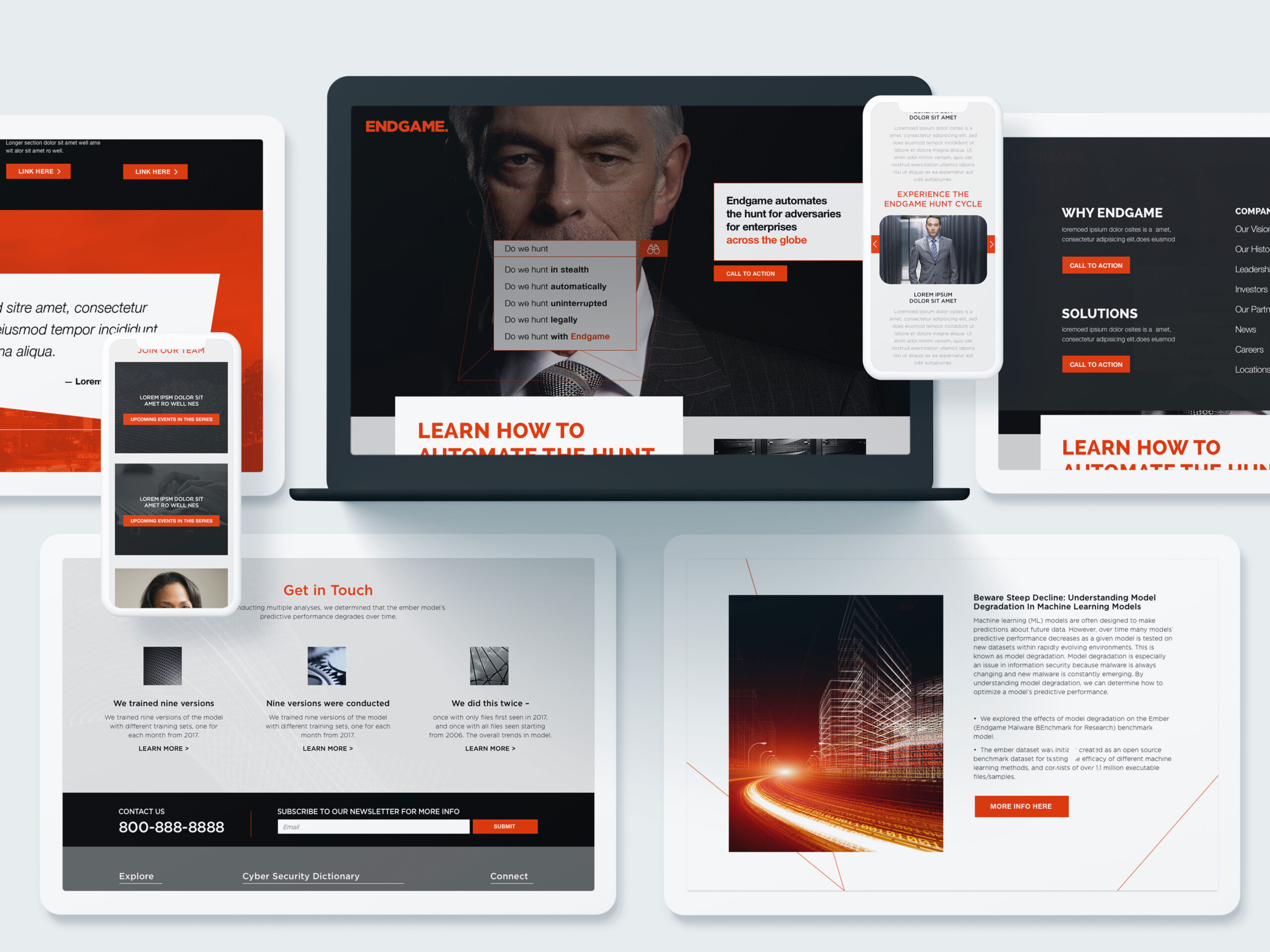

18. ThreatTrack (Vipre) Acquired by J2 Global
Summary: J2 Global acquired Vipre, a cybersecurity company, to expand its portfolio of internet security solutions.
Strategic Advantage: The acquisition allowed J2 Global to offer a more comprehensive suite of security products, enhancing its competitiveness in the cybersecurity market.
19. Lithium Merged with Khoros
Summary: Lithium Technologies merged with Spredfast to form Khoros, a customer engagement platform.
Strategic Advantage: The merger combined complementary technologies, enabling Khoros to offer integrated solutions for customer engagement across multiple channels.
20. PlanetRisk Acquired by Everbridge
Summary: Everbridge acquired PlanetRisk, a risk analytics company, to enhance its critical event management capabilities.
Strategic Advantage: This acquisition allowed Everbridge to provide more robust risk assessment and management solutions, strengthening its position in the critical event management sector.
21. PlanetRisk Federal Acquired by Culmen Technologies
Summary: In a move that deepens its national security and risk intelligence capabilities, Culmen Technologies acquired the federal business unit of PlanetRisk in early 2025. PlanetRisk Federal, known for delivering advanced geospatial, threat intelligence, and predictive analytics solutions to U.S. government agencies, strengthens Culmen’s footprint across the defense, intelligence, and homeland security markets. The acquisition aligns with Culmen’s strategy to expand its mission-critical support across the full threat lifecycle—combining operational expertise with enhanced data-driven insights.
Strategic Advantages: This acquisition brings immediate scale and capability lift to Culmen’s national security offerings. PlanetRisk Federal’s strengths in real-time situational awareness, data fusion, and predictive modeling directly complement Culmen’s existing programs in international security, logistics, and threat reduction.
22. BroadSoft Acquired by Cisco
Summary: Cisco acquired BroadSoft, a global leader in cloud-based communications, to enhance its cloud collaboration portfolio.
Strategic Advantage: This acquisition allowed Cisco to offer a comprehensive suite of unified communications solutions, strengthening its position in the cloud communications market.
23. CQ Roll Call Acquired by FiscalNote
Summary: FiscalNote acquired CQ Roll Call, a provider of congressional news and legislative tracking, to expand its policy and analysis offerings.
Strategic Advantage: The acquisition enabled FiscalNote to provide clients with a more robust set of tools for policy monitoring and analysis, enhancing its value proposition in the legislative intelligence market.
24. Mindtree Acquired by L&T
Summary: Larsen & Toubro (L&T) acquired Mindtree, an IT services and consulting company, to expand its digital services capabilities.
Strategic Advantage: This acquisition strengthened L&T’s position in the IT services sector, allowing it to offer a broader range of digital transformation solutions to clients.
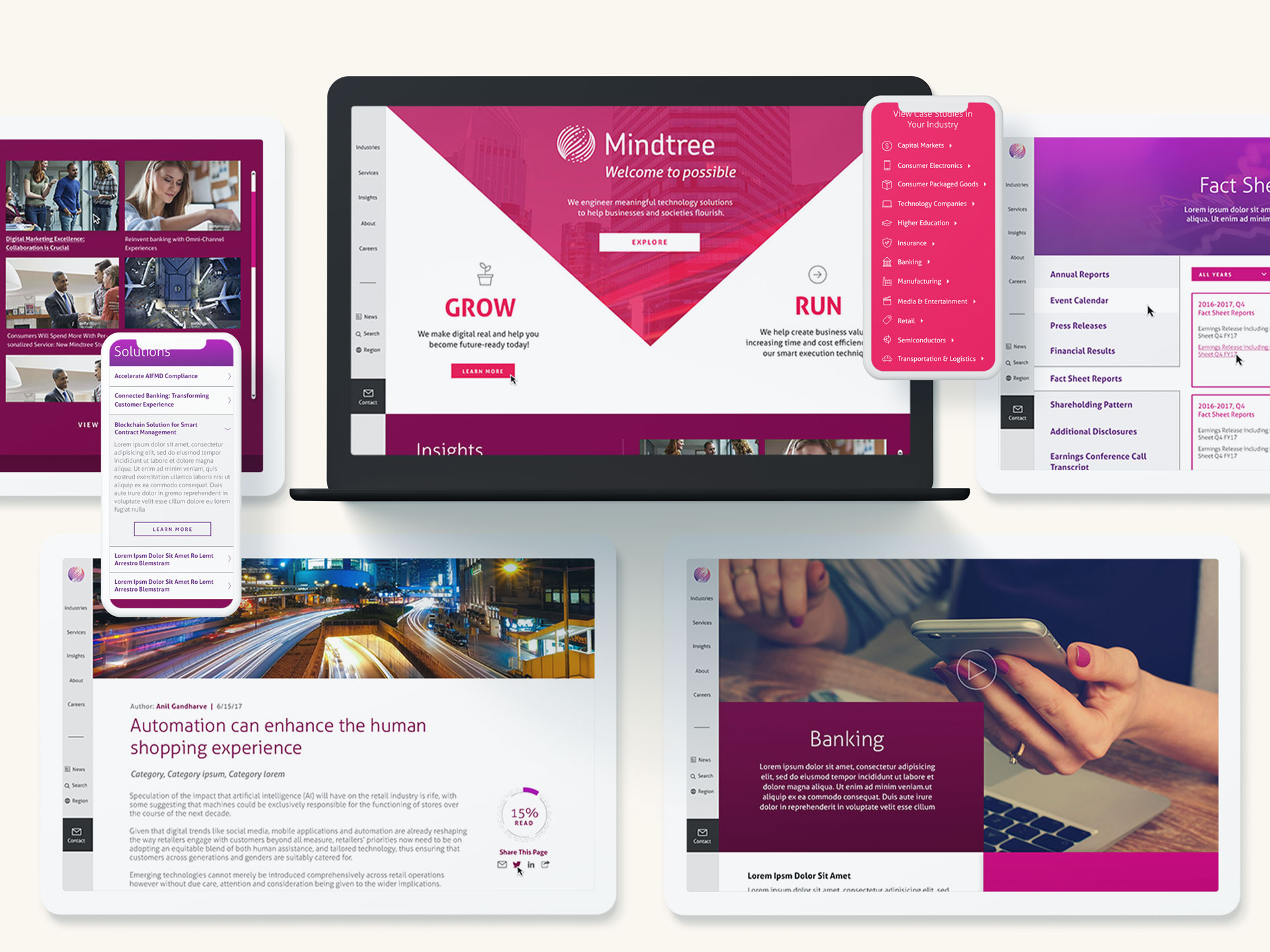

25. Earth Networks Acquired by Union Park Capital
Summary: Union Park Capital acquired Earth Networks, a provider of weather intelligence solutions, to enhance its environmental monitoring portfolio.
Strategic Advantage: The acquisition allowed Union Park Capital to expand its offerings in the environmental data sector, leveraging Earth Networks’ technology and expertise.
26. Endgame Acquired by Elastic
Summary: Elastic acquired Endgame, a security company specializing in endpoint protection, to integrate security capabilities into its search and analytics platform.
Strategic Advantage: This acquisition enabled Elastic to offer users integrated security solutions, enhancing its platform’s appeal to organizations seeking comprehensive data analysis and protection.
27. Cority Acquired by Thoma Bravo
Summary: Thoma Bravo acquired Cority, a provider of environmental, health, and safety (EHS) software, to expand its investment in the EHS sector.
Strategic Advantage: The acquisition allowed Thoma Bravo to leverage Cority’s market position and technology to drive growth in the EHS software market.
28. GoCanvas Acquired by K1
Summary: K1 Investment Management acquired GoCanvas, a mobile platform for businesses to automate workflows, to accelerate its growth and product development.
Strategic Advantage: This acquisition provided GoCanvas with resources to enhance its platform and expand its market reach, strengthening its position in the mobile workflow automation sector.
29. KnightPoint Acquired by Perspecta
Summary: Perspecta acquired KnightPoint Systems, a cybersecurity and IT services firm, to bolster its cybersecurity offerings for government clients.
Strategic Advantage: The acquisition enhanced Perspecta’s ability to provide comprehensive cybersecurity solutions, addressing the critical needs of federal agencies.
30. Bronfman Rothschild Acquired by NFP
Summary: NFP acquired Bronfman Rothschild, a wealth management firm, to expand its investment advisory services.
Strategic Advantage: This acquisition allowed NFP to enhance its wealth management capabilities, offering clients a broader range of financial planning and investment services.
31. LGS Innovations Acquired by CACI
Summary: CACI International acquired LGS Innovations, a provider of C4ISR and cybersecurity solutions, to strengthen its offerings for defense and intelligence clients.
Strategic Advantage: The acquisition bolstered CACI’s capabilities in communications and cybersecurity, enhancing its ability to serve national security missions.
32. Paya Goes Public via SPAC Merger with FinTech Acquisition Corp III
Summary: Paya, a leading integrated payments and commerce solutions provider, went public through a merger with FinTech Acquisition Corp III, a special purpose acquisition company (SPAC), in late 2020. The transaction positioned Paya on the NASDAQ under the ticker symbol “PAYA,” enabling it to access public capital markets while continuing its strategic expansion across high-growth verticals such as healthcare, education, non-profit, and field services.
Strategic Advantage: The SPAC merger offered Paya both financial and strategic runway to scale its operations in a competitive and rapidly evolving fintech landscape. Paya’s move exemplifies how verticalized fintech platforms can leverage public markets—not just for liquidity, but as a catalyst for category leadership and innovation.
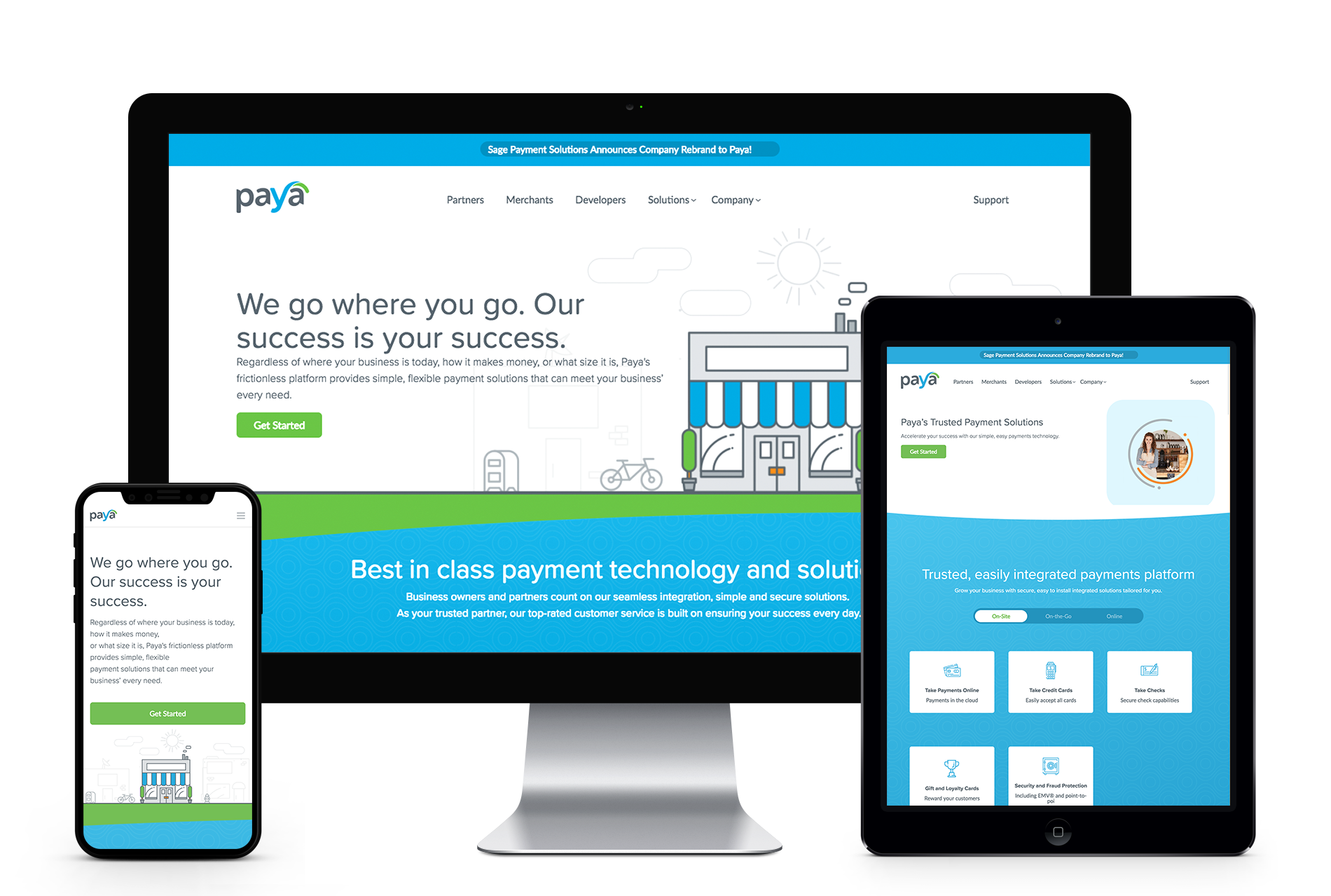

33. Centauri Acquired by KBR
Summary: KBR acquired Centauri, a provider of engineering and technology solutions for national security, to expand its defense and intelligence capabilities.
Strategic Advantage: This acquisition enhanced KBR’s position in the government solutions sector, allowing it to offer a broader range of services to defense and intelligence clients.
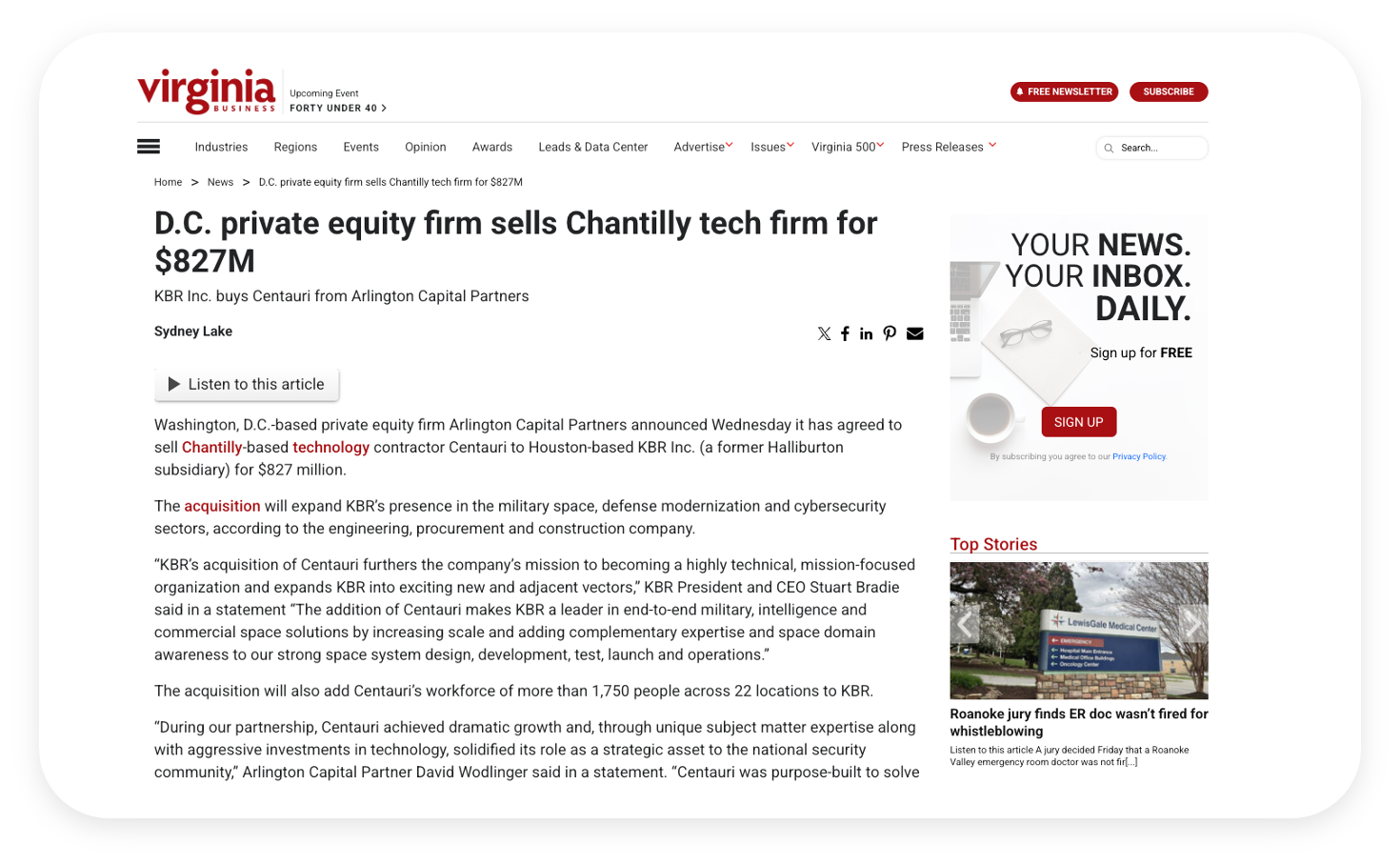

34. PacStar Acquired by Curtiss-Wright
Summary: Curtiss-Wright acquired PacStar, a provider of tactical communications solutions, to enhance its defense electronics portfolio.
Strategic Advantage: The acquisition strengthened Curtiss-Wright’s offerings in battlefield communications, providing integrated solutions for military applications.
35. Alfresco Acquired by Hyland
Summary: Hyland acquired Alfresco, an open-source content services provider, to expand its content management capabilities.
Strategic Advantage: This acquisition allowed Hyland to offer a more comprehensive suite of content services solutions, catering to a broader range of industries and use cases.
36. Cloudera Acquired by KKR and CD&R
Summary: Investment firms KKR and Clayton, Dubilier & Rice (CD&R) acquired Cloudera, a data management and analytics company, to take it private and drive its next phase of growth.
Strategic Advantage: The acquisition provided Cloudera with resources and strategic guidance to enhance its product offerings and expand its market presence in the data analytics sector.
37. Clarabridge Acquired by Qualtrics
Summary: Qualtrics acquired Clarabridge, a customer experience management platform, to enhance its experience management capabilities.
Strategic Advantage: This acquisition allowed Qualtrics to offer more robust customer insights and analytics solutions, strengthening its position in the experience management market.
38. Blue Yonder Acquired by Panasonic
Summary: Panasonic acquired Blue Yonder, a supply chain management software company, to enhance its autonomous supply chain capabilities.
Strategic Advantage: The acquisition enabled Panasonic to integrate Blue Yonder’s AI-driven supply chain solutions with its hardware offerings, providing comprehensive solutions for logistics and manufacturing clients.


39. MuseDev Acquired by Sonatype
Summary: Sonatype acquired MuseDev, a software quality automation company, to enhance its software supply chain management platform.
Strategic Advantage: This acquisition allowed Sonatype to offer integrated code quality and security solutions, helping organizations manage and secure their software development processes.
40. Abaco Systems Acquired by Ametek
Summary: Ametek acquired Abaco Systems, a provider of embedded computing solutions, to expand its electronic instruments and electromechanical devices portfolio.
Strategic Advantage: The acquisition strengthened Ametek’s position in the defense and industrial markets, leveraging Abaco’s embedded computing expertise.
41. Perspecta Acquired by Peraton
Summary: Peraton acquired Perspecta, a government services provider, to create a leading government technology solutions contractor.
Strategic Advantage: The acquisition combined complementary capabilities, enhancing Peraton’s ability to deliver comprehensive solutions to federal agencies.


42. BigBear.ai Goes Public via SPAC Merger with GigCapital4
Summary: BigBear.ai, an AI-powered analytics company, merged with GigCapital4, a special purpose acquisition company, to become a publicly traded entity.
Strategic Advantage: The merger provided BigBear.ai with capital to accelerate growth and expand its AI analytics offerings across various sectors.
43. ResMan Acquired by Inhabit IQ
Summary: Inhabit IQ, a collective of tech-forward products serving the property management industry, acquired ResMan, a leading property management SaaS platform provider.
Strategic Advantage: This acquisition allowed Inhabit IQ to enhance its suite of solutions for multifamily and commercial property management, offering more comprehensive and integrated services to its clients.
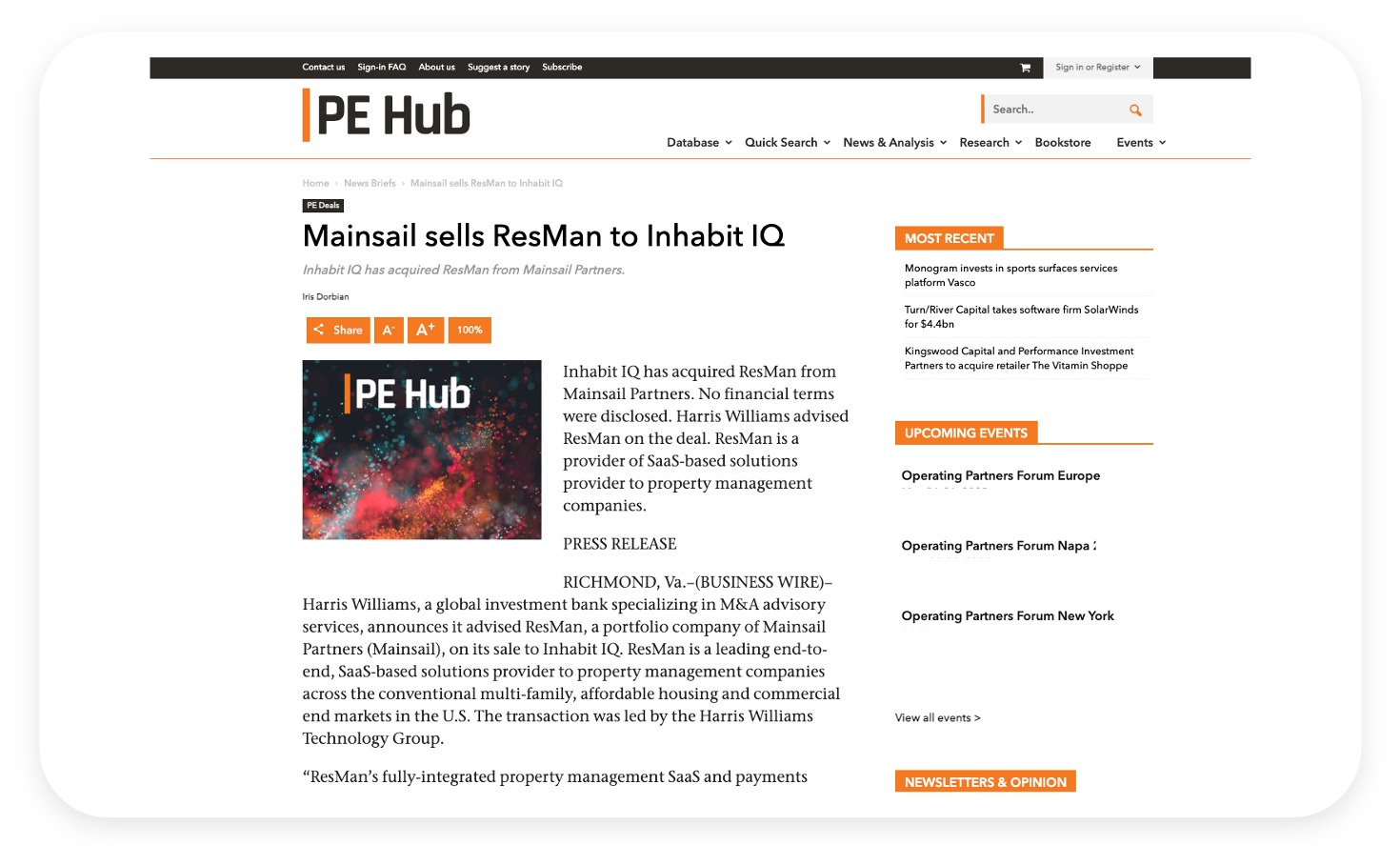

44. Narrative Science Acquired by Salesforce
Summary: Salesforce acquired Narrative Science, a data storytelling company, integrating its capabilities into Salesforce’s Tableau Software.
Strategic Advantage: This acquisition enhanced Tableau’s analytics platform by adding automated data storytelling features, enabling users to better understand and communicate data insights.
45. Quest Acquired by Clearlake Capital
Summary: Clearlake Capital Group completed the acquisition of Quest Software, a global cybersecurity, data intelligence, and IT operations management software provider.
Strategic Advantage: The acquisition aimed to accelerate Quest’s growth and drive momentum in its cybersecurity and data intelligence solutions, leveraging Clearlake’s resources and expertise.


46. Cvent Goes Public via SPAC Merger with Dragoneer Growth Opportunities Corp. II
Summary: Cvent, a meetings, events, and hospitality technology provider, completed its merger with Dragoneer Growth Opportunities Corp. II, a special purpose acquisition company, and began trading on the Nasdaq as “CVT.”
Strategic Advantage: The merger provided Cvent with capital to accelerate product innovation and expand its market presence in the event technology sector.
47. ID Technologies Acquired by CACI
Summary: CACI International acquired ID Technologies, an enterprise IT and network modernization provider with NSA-compliant Commercial Solutions for Classified (CSfC) technology.
Strategic Advantage: The acquisition expanded CACI’s secure network modernization capabilities, enhancing its offerings for U.S. government clients requiring classified communication solutions.
48. Citrix Acquired by Vista Equity Partners and Evergreen Coast Capital
Summary: Affiliates of Vista Equity Partners and Evergreen Coast Capital completed the acquisition of Citrix Systems, a leader in cloud computing and virtualization technology, in an all-cash transaction valued at $16.5 billion.
Strategic Advantage: The acquisition aimed to take Citrix private, allowing the company to accelerate its SaaS transformation and expand its platform for secure hybrid work solutions.
49. ManTech Acquired by Carlyle Group
Summary: Global investment firm Carlyle Group acquired ManTech International, a cyber and technology contractor for defense, intelligence, and civilian agencies, in an all-cash transaction valued at approximately $4.2 billion.
Strategic Advantage: The acquisition aimed to leverage ManTech’s expertise in cybersecurity and technology solutions to enhance Carlyle’s portfolio in the government services sector.
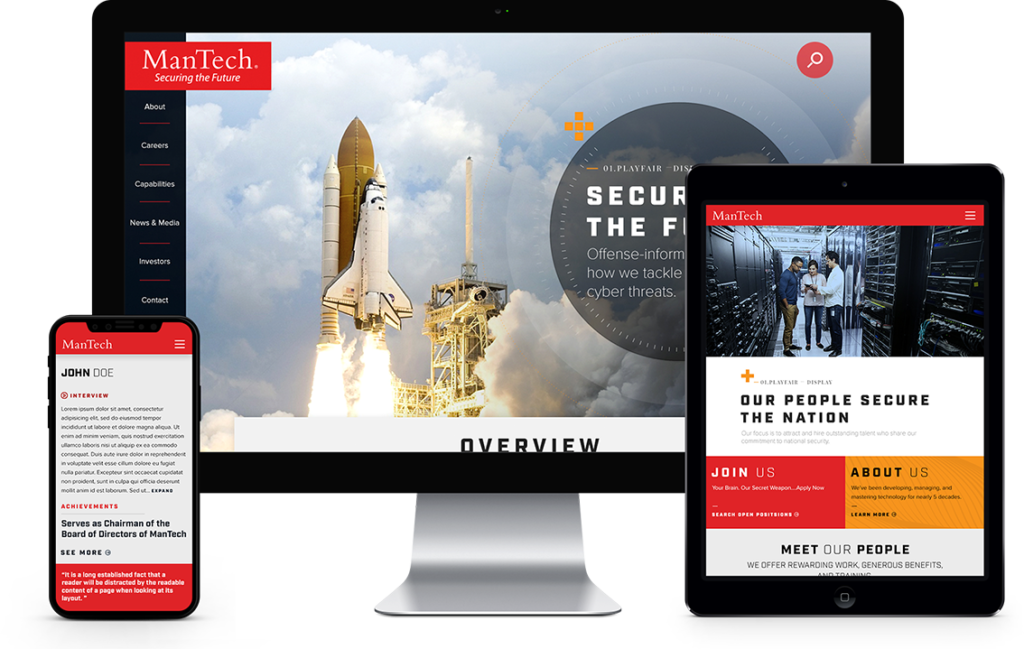

50. Level Access Merged with eSSENTIAL Accessibility
Summary: Level Access, a provider of enterprise digital accessibility solutions, merged with eSSENTIAL Accessibility, a pioneer of Accessibility-as-a-Service, to create a comprehensive digital accessibility solutions provider.
Strategic Advantage: The merger combined complementary technologies and expertise, accelerating the mainstream adoption of digital accessibility and offering end-to-end solutions for clients.
51. Cybeats Technologies Listed on the Canadian Securities Exchange
Summary: Cybeats Technologies Corp., a cybersecurity company specializing in Software Bill of Materials (SBOM) management and software supply chain intelligence, commenced trading on the Canadian Securities Exchange under the symbol “CYBT.”
Strategic Advantage: The listing provided Cybeats with access to public capital markets, enabling it to expand its cybersecurity solutions and address the growing demand for software supply chain security.
52. Octo Acquired by IBM
Summary: IBM announced the acquisition of Octo, a U.S.-based IT modernization and digital transformation services provider serving the federal government.
Strategic Advantage: The acquisition aimed to establish one of the largest digital transformation partners for the federal government, enhancing IBM’s consulting capabilities in the public sector.
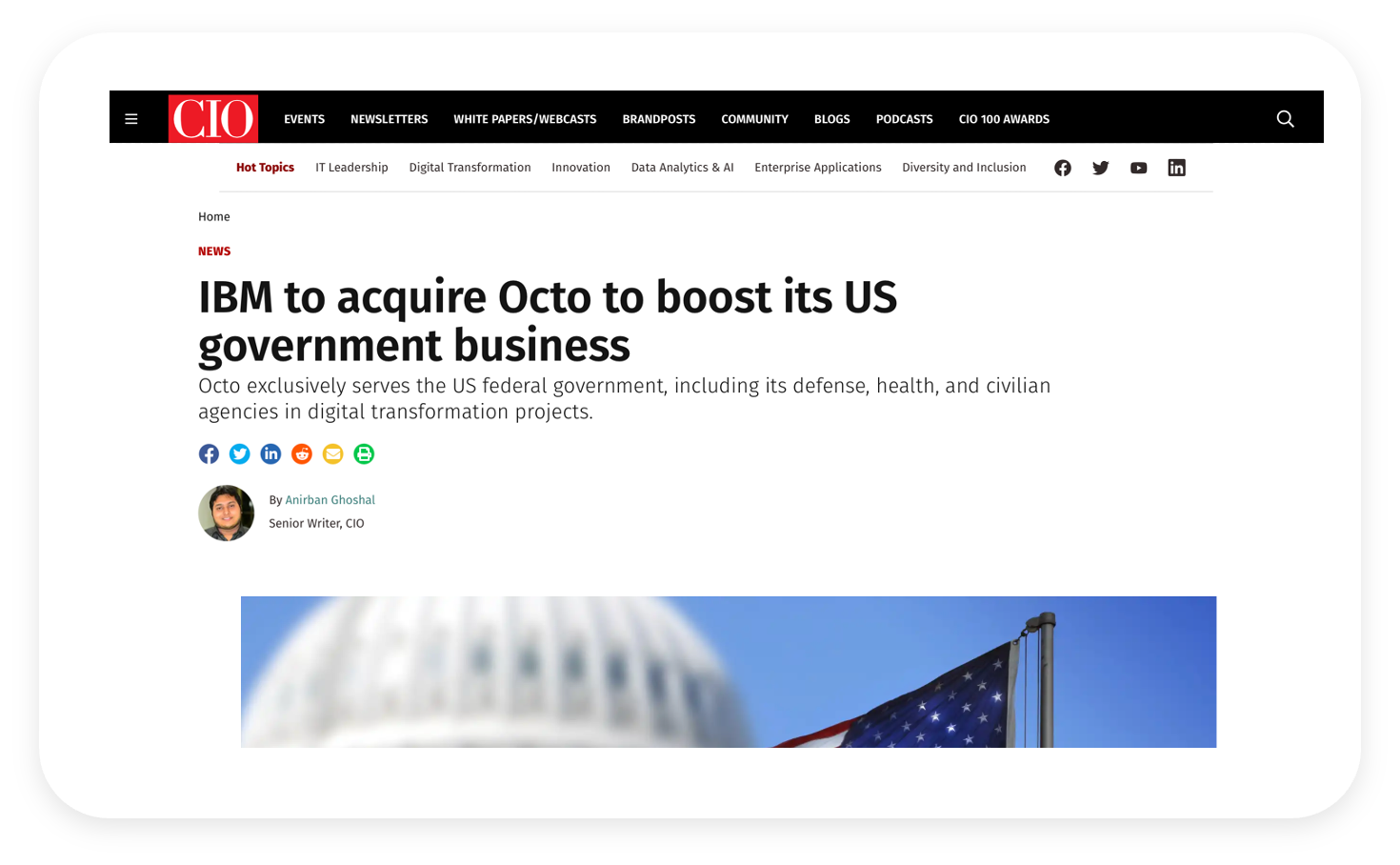

53. Cohen & Company Merged into Marcum
Summary: Marcum LLP, a national accounting and advisory services firm, merged with E. Cohen & Company, CPAs, a Rockville, Maryland-based accounting firm.
Strategic Advantage: The merger expanded Marcum’s presence in the Mid-Atlantic region and enhanced its service offerings to clients in the area.
54. Illusive Acquired by Proofpoint
Summary: Proofpoint, a cybersecurity and compliance company, acquired Illusive, a leader in Identity Threat Detection and Response (ITDR).
Strategic Advantage: The acquisition strengthened Proofpoint’s threat and information protection platforms, providing customers with a unified solution to address identity-based threats.
55. SpaceIQ Merged with iOffice to Form Eptura
Summary: SpaceIQ and iOffice, key players in workplace management software, merged to form Eptura, a unified “worktech” powerhouse. This consolidation, backed by private equity firms Thoma Bravo and JMI Equity, pooled together SpaceIQ’s integrated workplace solutions (including legacy brands Archibus and Serraview) with iOffice’s asset management tools. The merger coincided with Condeco’s integration, as all three converged to create a comprehensive workplace experience platform.
Strategic Advantages: By forming Eptura, the companies expanded their market reach and product breadth. Eptura offers end-to-end workplace and asset management, addressing hybrid work challenges with solutions for space planning, resource scheduling, and asset tracking. The combined entity leverages shared R&D to accelerate innovation and respond to the evolving “future of work” demands. With Thoma Bravo and JMI’s backing, Eptura gains financial heft to invest in technology like AI-driven workspace analytics, plus cross-selling opportunities to a broad customer base. BlueText’s branding of SpaceIQ ensured the new venture launched with a strong digital presence, clearly communicating the benefits of the merger to customers and investors.


56. Dynamyx (Inspirata) Acquired by Fujifilm
Summary: Fujifilm Healthcare acquired the Dynamyx digital pathology business from Inspirata, integrating Inspirata’s FDA-cleared digital pathology platform into Fujifilm’s medical imaging portfolio. The deal included Dynamyx software, employees, and IP, giving Fujifilm a foothold in pathology informatics.
Strategic Advantages: For Fujifilm, acquiring Dynamyx accelerates its push into digital healthcare solutions. Fujifilm established a new digital pathology division to combine Dynamyx with its Synapse® Enterprise Imaging suite, aiming to integrate pathology images into hospital EHR systems. This creates a one-stop solution for radiology and pathology imaging, streamlining cancer diagnostics for care teams. Fujifilm can now leverage Dynamyx’s open architecture and multi-scanner support to challenge other industry players (like Philips). For Inspirata, the acquisition validated its technology and allowed its pathology innovations to scale globally under Fujifilm’s umbrella. BlueText’s earlier efforts in building Inspirata’s brand narrative around patient impact likely contributed to its credibility and appeal, showcasing the power of strategic branding in M&A outcomes.
57. Revegy Acquired by Dura Software
Summary: Revegy, a sales optimization and revenue enablement software provider, was acquired by Dura Software in November 2022. Dura, known for buying “hyper-niche” software companies, made Revegy its 11th acquisition. Revegy’s platform helps enterprise sales teams manage complex accounts and relationships, functioning as a CRM-agnostic solution with 30,000 global users.
Strategic Advantages: With Revegy, Dura expanded its portfolio into sales enablement software, complementing existing holdings like 6Connex and Moki. The acquisition allows cross-pollination of technology and customers: Dura can infuse operational expertise and capital to grow Revegy’s product suite and market reach. For Revegy, joining Dura provides resources to innovate features (like AI-driven account insights) and enter new verticals under the umbrella of a company committed to “best-in-class” software solutions. Dura’s hyper-niche strategy means Revegy will receive focused attention to remain a leader in its segment. Bluetext’s emphasis on clear value storytelling in M&A would help communicate to Revegy’s clients that the acquisition strengthens long-term product support and innovation, reassuring them during the transition.
58. CertainPath Merged with Mojio
Summary: CertainPath (formerly Success Group International), a provider of software and training for home service contractors, partnered/merged with Mojio to integrate Mojio’s connected fleet management platform (“Force by Mojio”) into CertainPath’s offering. This tie-up was described as joining forces rather than a full acquisition, but it effectively merges Mojio’s telematics services with CertainPath’s contractor management systems.
Strategic Advantages: The integrated solution provides home service businesses a seamless way to manage both operations and vehicles. CertainPath’s members (plumbers, HVAC, electricians, etc.) can access real-time van/truck tracking, driver safety scores, and maintenance alerts within the same platform they use for job scheduling and invoicing. This enhances operational efficiency: contractors reduce fuel costs and improve on-time service by routing and dispatching smarter. Mojio gains distribution to CertainPath’s nationwide member base, expanding its reach in the $650B home services market. By merging software and telematics, the partnership delivers an end-to-end solution competitors will find hard to match.
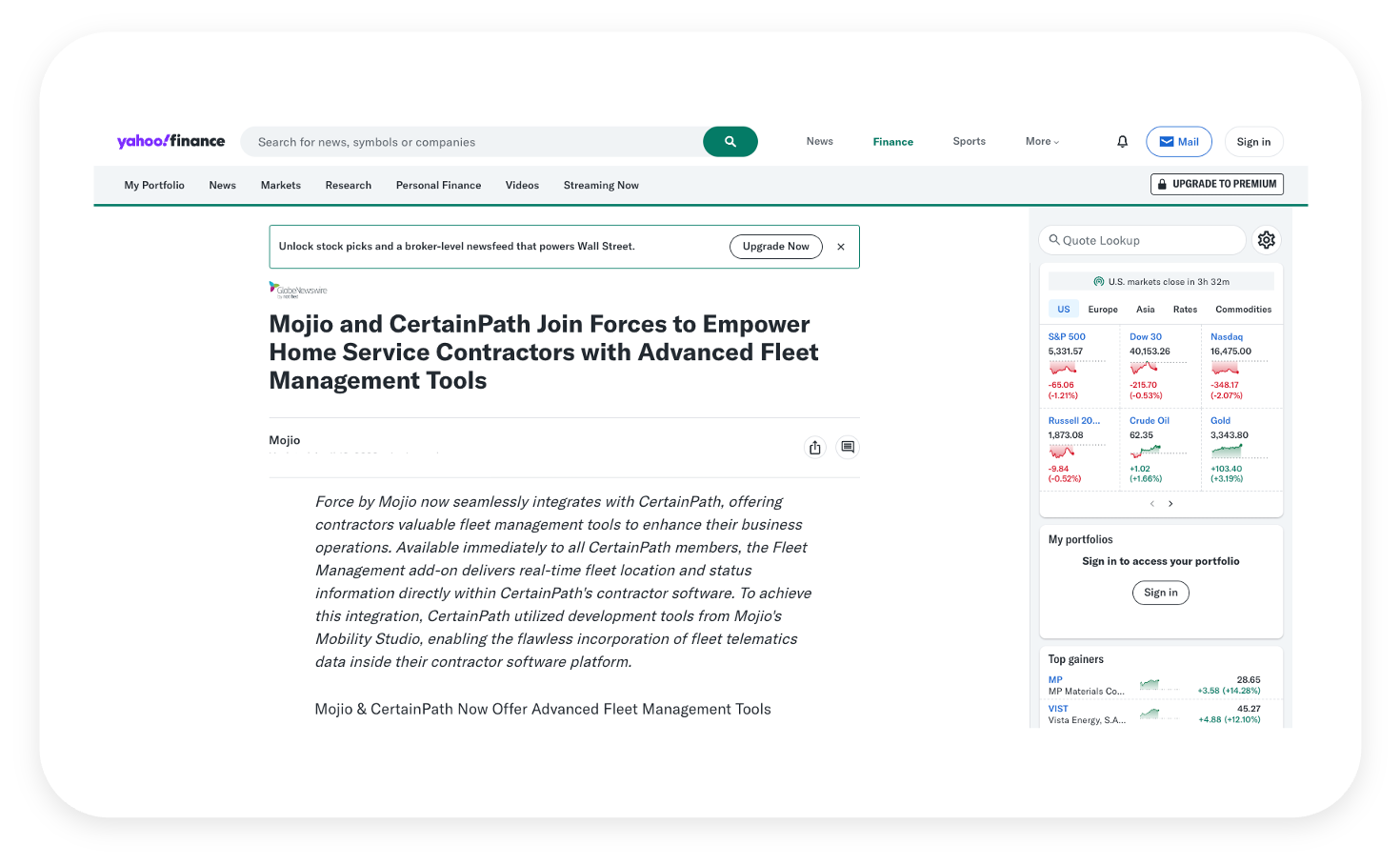

59. Micro Focus Acquired by OpenText
Summary: In a mega-software deal, Canada’s OpenText acquired UK-based Micro Focus for roughly $6 billion. The acquisition (closed in early 2023) combined OpenText’s enterprise information management cloud software with Micro Focus’s legacy IT operations, security, and DevOps tools, nearly doubling OpenText’s revenue.
Strategic Advantages: OpenText’s goal is to become one of the world’s largest software and cloud businesses. By absorbing Micro Focus, OpenText instantly added a “tremendous marquee customer base” and expanded its product portfolio into mainframe software, cybersecurity, and IT management. There’s significant cross-sell opportunity: OpenText can offer its cloud-based information management to Micro Focus’s customers, while modernizing Micro Focus’s offerings with cloud and AI capabilities. The deal also promised ~$400M in cost synergies via consolidation, though it involved workforce reductions. This scale and breadth better positions OpenText against competitors like IBM.
60. Paya Acquired by Nuvei
Summary: Nuvei, a Canadian fintech, acquired Paya (a U.S. integrated payments processor) for $1.3 billion in an all-cash deal, completed in February 2023. Paya specializes in payments embedded in software for sectors like non-profits, utilities, and B2B – complementing Nuvei’s global e-commerce payment platform.
Strategic Advantages: The acquisition created a payments powerhouse spanning global e-commerce and high-growth integrated payments. Nuvei gains Paya’s 300+ software integrations and strong foothold in U.S. B2B and government/utility payments. This diversifies Nuvei’s revenue streams, adding counter-cyclical stability (B2B and bill-pay tend to be less volatile than consumer retail). Technologically, plugging Paya into Nuvei’s platform enhances Nuvei’s offering with ACH processing, invoicing, and other capabilities Paya excels in. Nuvei’s CEO noted it speeds Nuvei’s growth into new verticals and allows them to offer a more comprehensive, “revenue-driving” payment solution to merchants.
61. Cvent Acquired by Blackstone
Summary: Event-management software leader Cvent was taken private by Blackstone in a $4.6 billion deal, completed mid-2023. Blackstone, a global PE firm, bought Cvent’s outstanding shares (at $8.50/share) and delisted the company from Nasdaq.
Strategic Advantages: As a private entity under Blackstone, Cvent can pursue long-term growth strategies away from public market pressures. Blackstone’s investment provides capital and industry connections (especially in hospitality) to help Cvent innovate its SaaS for meetings and events. The deal came as tech valuations dipped, giving Blackstone a bargain for a firm once valued higher. Blackstone can streamline Cvent’s operations (they reportedly planned cost cuts and workforce optimization) and potentially merge Cvent with other portfolio companies to expand its reach (e.g., combining with venue or travel tech assets). For Cvent, the infusion of resources and strategic guidance means accelerated development of its event marketing platform and possibly acquisitions of complementary tech (indeed, after going private, Cvent quickly acquired other software like Jifflenow).
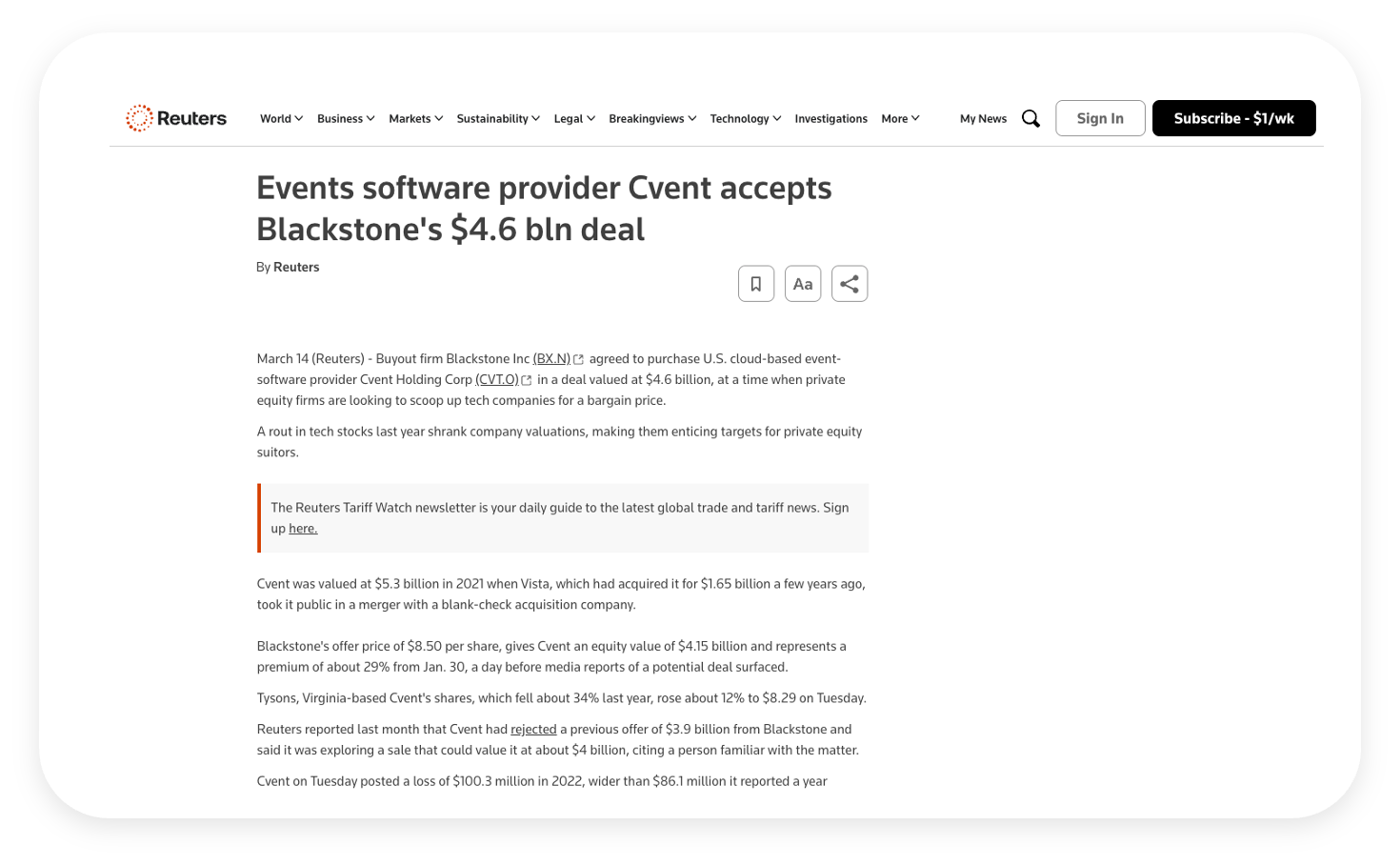

62. LookingGlass Acquired by ZeroFox
Summary: External cybersecurity firm ZeroFox (focused on digital risk protection) acquired LookingGlass Cyber Solutions for about $26 million in 2023. LookingGlass brought expertise in external attack surface management (EASM) and threat intelligence, complementing ZeroFox’s social media and digital threat hunting platform.
Strategic Advantages: The acquisition allowed ZeroFox to offer a full-spectrum external cyber risk platform. By folding in LookingGlass, ZeroFox added capabilities to monitor clients’ entire internet-facing footprint (domains, IPs, infra) and not just social/digital channels. This broadens ZeroFox’s value proposition to CISO customers: one vendor for brand protection, dark web monitoring, and attack surface reduction. Financially, acquiring at $26M (primarily in stock) was relatively inexpensive, leveraging ZeroFox’s then-public stock currency. Post-IPO, ZeroFox likely sought growth via acquisitions to meet shareholder expectations. With LookingGlass, ZeroFox could upsell new services to its base and attract larger enterprise deals with a more comprehensive suite.
63. VMware Acquired by Broadcom
Summary: Broadcom Inc. – known for semiconductors and enterprise software – acquired VMware for approximately $69 billion in a cash-and-stock deal. Finalized in late 2023 after regulatory delays, this landmark merger combined Broadcom’s infra and security software (CA, Symantec enterprise) with VMware’s cloud and virtualization suite.
Strategic Advantages: Broadcom aims to build “the world’s leading infrastructure technology company”. With VMware, Broadcom gains a dominant position in multi-cloud services used by enterprises globally. The strategic logic: pair Broadcom’s existing mainframe and security software with VMware’s cloud offerings to sell an integrated stack to large customers. The deal also nearly doubles Broadcom’s software revenue, diversifying beyond semiconductors. Broadcom touts significant synergies – both cost (via efficiencies, unfortunately including layoffs) and revenue (by cross-selling VMware to its clients). There are innovation benefits too: Broadcom’s resources can help VMware accelerate R&D in cloud networking, AI integration, and edge computing. For VMware users, Broadcom has pledged to continue support and investment (though some customers have warily watched pricing). Communication strategy would stress continuity and enhanced support: “VMware’s innovation + Broadcom’s scale = better solutions for your multi-cloud future”.
64. Imageware Systems Acquired by TECH5
Summary: Swiss-based biometrics company TECH5 acquired the assets of Imageware Systems (a U.S. biometric authentication firm) in early 2023. The deal included all software, patents, and key staff of Imageware, known for biometric identity management solutions for law enforcement and enterprise.
Strategic Advantages: This acquisition strengthened TECH5’s presence in North America and broadened its biometric product suite. TECH5, which provides fingerprint, face, and iris recognition tech, can integrate Imageware’s user-friendly biometric software (including its multimodal biometric management platform) to offer more complete solutions. Gaining Imageware’s patents accelerates TECH5’s innovation pipeline and possibly opens new verticals (Imageware had government and law enforcement clients). Importantly, TECH5 can reassure Imageware’s existing customers by continuing support and improving the acquired products with TECH5’s AI algorithms. The combination promises “the best UI and AI-driven authentication software” under one roof. Marketing wise, TECH5 pitched this as combining TECH5’s biometrics engines with Imageware’s proven front-end solutions, delivering more accurate and user-friendly ID systems.
65. RiskLens Acquired by Safe Security
Summary: Safe Security, a Palo Alto-based cyber risk management firm, acquired RiskLens in mid-2023. RiskLens is the pioneer of cyber risk quantification using the FAIR model (Factor Analysis of Information Risk). By joining forces, Safe Security aimed to create the undisputed leader in Cyber Risk Quantification (CRQ) and management.
Strategic Advantages: The combination marries RiskLens’ quantitative risk modeling with Safe’s real-time risk scoring platform, yielding a comprehensive view of cyber risk in financial terms. Customers benefit from automated, data-driven risk assessments that align with business impact – essentially, a “single pane of glass” for CISOs to prioritize security investments. Safe Security can now answer Board-level questions (“How much risk in dollars are we carrying?”) by leveraging RiskLens’ FAIR-standard calculations, something competitors may lack. This move differentiates Safe in the $4B CRQ market as a one-stop leader. Culturally, both companies focus on translating cyber metrics into business language, so integration is smoother. The strategic messaging is about transformation: “Together, we transform cyber risk management from guesswork into science.” This resonates with enterprise clients and was indeed the pitch – empowering customers with a real-time, standard model to manage risk proactively. In sum, Safe + RiskLens gives enterprises a powerful tool to make smarter, financially grounded security decisions, reinforcing Safe’s vision of holistic, AI-driven cyber risk management.
66. Ardent Acquired by Mission1st Group
Summary: Government IT contractor Mission1st Group acquired Ardent Management Consulting (Ardent MC) in mid-2024. Ardent is a 17-year-old digital transformation and geospatial analytics provider for federal agencies, and Mission1st (a veteran-owned firm) focuses on defense IT and engineering.
Strategic Advantages: This acquisition combines Mission1st’s defense market success with Ardent’s deep civilian agency expertise. Mission1st can now offer a broader slate of services – from military communications support to civilian agency cloud and data analytics – under one roof. For Ardent, joining Mission1st brings scale and access to Mission1st’s defense contracts, potentially opening new revenue streams (e.g., applying Ardent’s geospatial tech to DoD needs). The two companies’ capabilities are complementary, allowing cross-pollination of solutions (like Ardent’s location intelligence for Mission1st’s Army clients, or Mission1st’s cyber skills for Ardent’s DHS clients). Leadership quoted in the announcement highlighted leveraging “collective strengths” to enhance delivery for all customers. Strategically, the deal creates a mid-sized GovCon competitor with both DoD and civilian past performance – making them more competitive for large multi-agency IT contracts. Communications wise, the integration likely rebranded Ardent as “Ardent, a Mission1st company,” focusing on continuity of services.
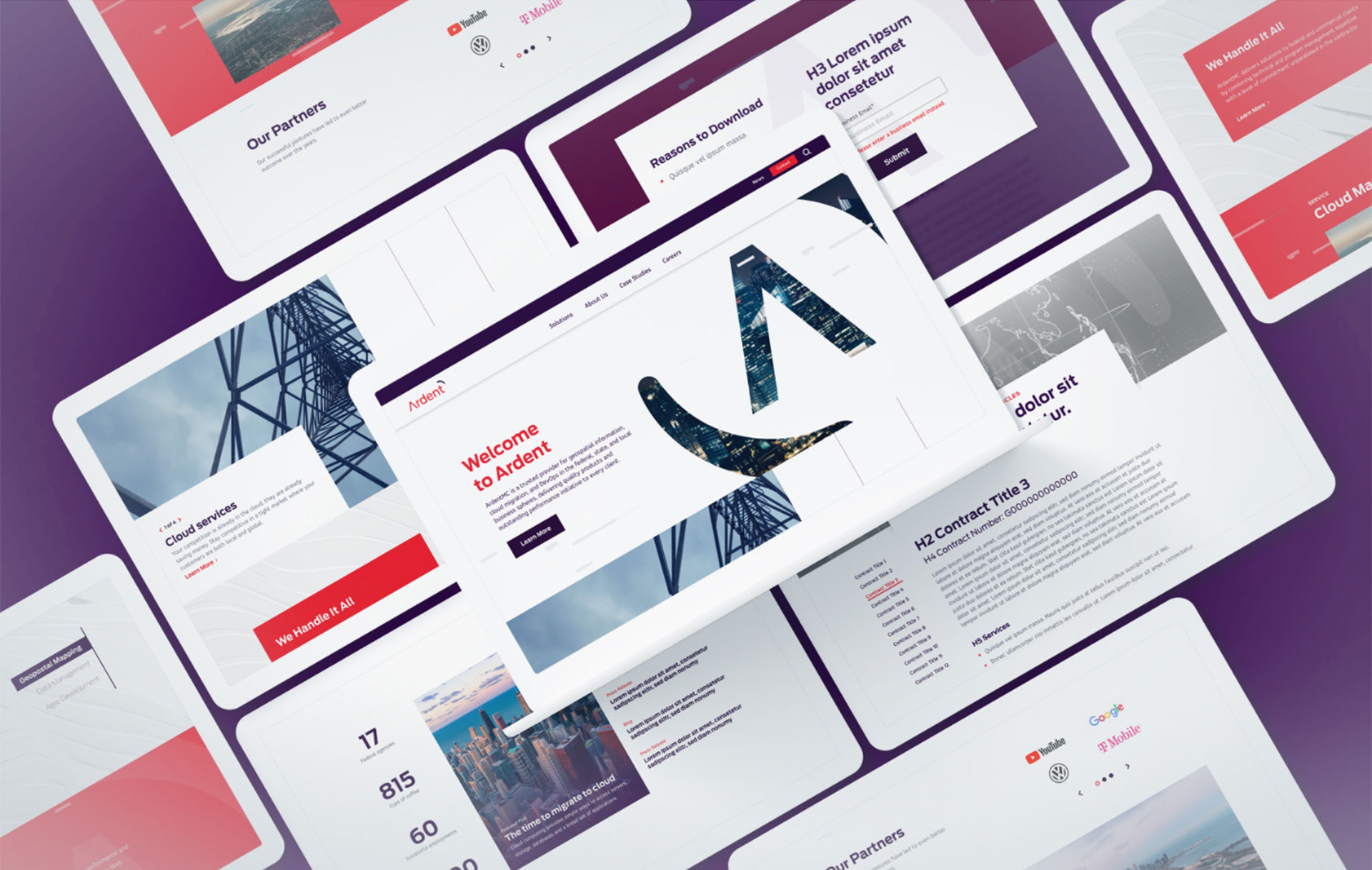

67. Verve Industrial Acquired by Rockwell Automation
Summary: Industrial automation giant Rockwell Automation acquired Verve Industrial Protection (an OT/ICS cybersecurity firm) in late 2023. Verve offers a unified platform for asset discovery, vulnerability assessment, and threat monitoring in operational technology (factory and utility networks).
Strategic Advantages: Rockwell’s acquisition of Verve reflects the trend of IT-OT convergence: marrying industrial controls with robust cybersecurity. By embedding Verve’s vendor-neutral OT security platform into its offerings, Rockwell can now deliver a turnkey solution to its manufacturing and energy customers – not just automating processes but also securing them. This is a critical differentiator as cyber threats to critical infrastructure rise. The move expands Rockwell’s suite in its software & services segment, likely offering Verve’s solution alongside Rockwell’s FactoryTalk software. Rockwell gains Verve’s domain expertise and its established client base in industries like oil & gas and utilities. Moreover, Verve’s capability to secure multi-vendor environments appeals to customers who run mixed control systems. Financially, at an estimated $190M price, it’s a relatively small acquisition for Rockwell with potentially big returns via new service contracts and recurring revenue (cyber monitoring subscriptions). In terms of marketing, Rockwell can now message a “secure automation” story: “We not only optimize your operations, we protect them.” That alignment of mission likely guided the communications around the deal, emphasizing enhanced reliability and safety for clients.
68. ZeroFox Acquired by Haveli
Summary: In May 2024, ZeroFox – a Baltimore-based external cybersecurity firm – was acquired and taken private by Haveli Investments for $350M. Haveli, a tech-focused PE firm in Austin, paid $1.14/share, a 45% premium on the 90-day stock price, and delisted ZeroFox from the Nasdaq.
Strategic Advantages: Going private under Haveli gives ZeroFox capital and strategic support to scale without public market pressure. Haveli likely sees long-term potential in ZeroFox’s platform (which includes AI threat intelligence, digital risk protection, and recent acquisitions like LookingGlass). With Haveli’s backing, ZeroFox can invest in R&D (perhaps developing new AI-driven threat disruption tools) and pursue new go-to-market channels (like MSSP partnerships or global expansion). The infusion of resources comes at a crucial time as cybersecurity threats proliferate; ZeroFox can now expand its external threat intelligence network and automation (“Disruption”) capabilities. Also, Haveli’s network might help ZeroFox land larger enterprise deals or federal contracts. For ZeroFox’s existing customers, Haveli’s ownership was positioned as a positive: more focus on innovation and customer success rather than quarterly earnings. Messaging from the CEO echoed this, noting the partnership will help “build a safer digital world” and accelerate product innovation. In short, as a private company ZeroFox can be more agile and aggressive in a fast-moving cyber market.
69. Eqlipse Technologies Acquired by BlueHalo
Summary: In early 2024, BlueHalo – a fast-growing defense tech firm – announced it will acquire Eqlipse Technologies, a provider of cybersecurity, signals intelligence, and cyber solutions to DoD and the Intelligence Community. Both were Arlington Capital portfolio companies, effectively merging under BlueHalo’s banner.
Strategic Advantages: Combining BlueHalo and Eqlipse creates a mid-tier defense tech powerhouse nearing $1B in revenue with 2,400 employees. BlueHalo gains Eqlipse’s high-end talent and products in cyber and RF sensing, enhancing BlueHalo’s capabilities in Space, c-UAS, electronic warfare, and AI. The merged entity can bid more competitively on large DoD programs, positioned as an alternative to the biggest primes by offering innovation without bureaucracy. Eqlipse was less than a year old under that brand, and now its identity and offerings bolster BlueHalo’s portfolio (indeed, BlueHalo cited Eqlipse’s contribution to Space Force’s $1.4B SCAR program). Culturally and strategically, both companies share a focus on rapid prototyping and mission-focused R&D, which the merger amplifies.
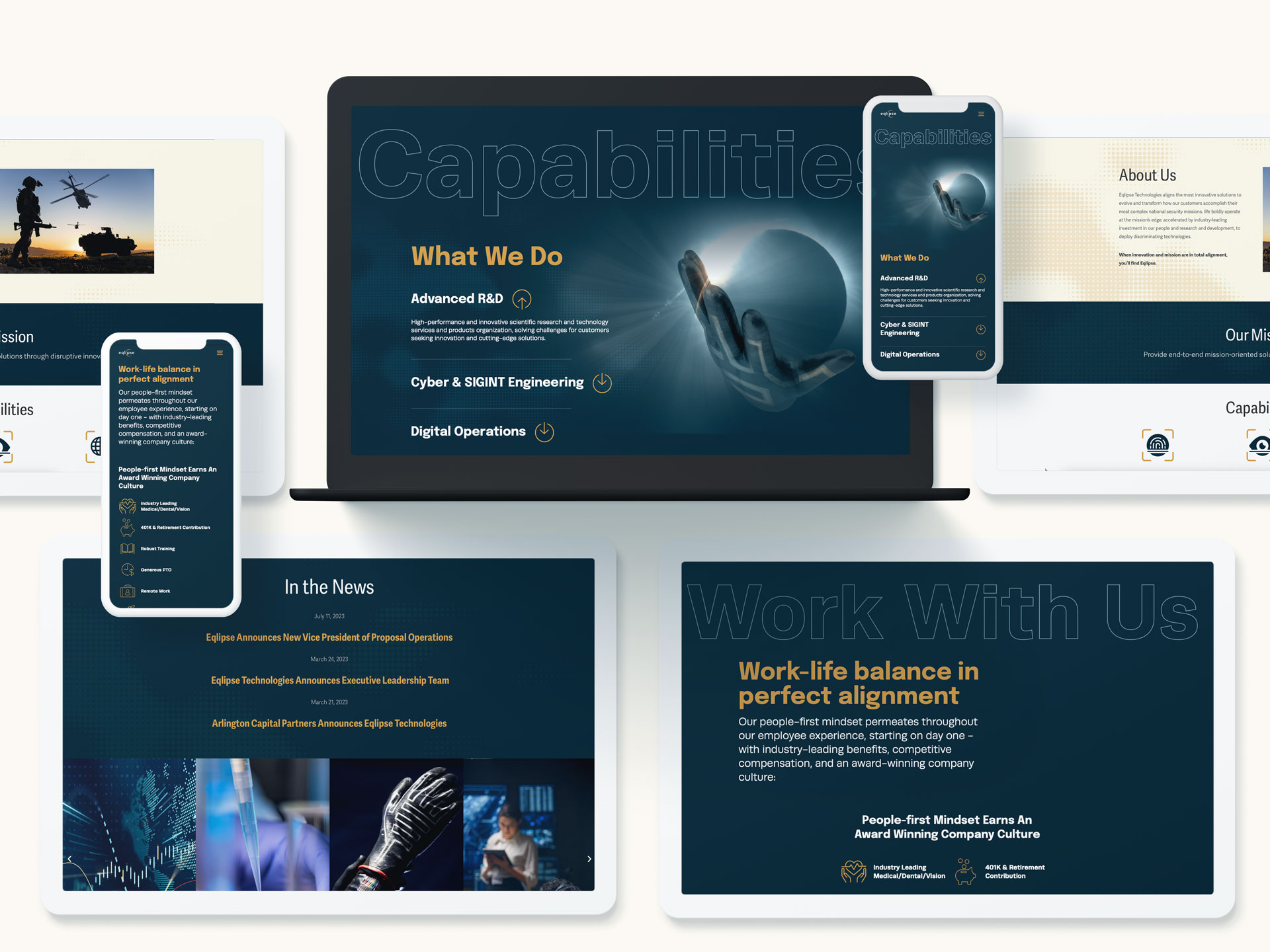

70. Fastpath Acquired by Delinea
Summary: Privileged access management (PAM) company Delinea acquired Fastpath Solutions, an identity governance and access control software provider, closing in April 2024. Fastpath’s products help manage user access rights and SOD (segregation of duties) across business applications like ERP systems.
Strategic Advantages: The acquisition enables Delinea to offer an end-to-end identity security platform, blending PAM with Identity Governance and Administration (IGA). With Fastpath, Delinea can dynamically control user permissions in applications (like finance or HR systems) in addition to managing privileged accounts on servers and endpoints. This means customers get a unified view of who has what access and the ability to remediate risks (like over-privileged users or toxic combinations of access) automatically. As cybersecurity moves toward zero trust and least privilege, merging these capabilities is powerful. Delinea’s CEO said it solves complex identity challenges by connecting previously siloed solutions. It also positions Delinea against giants like CyberArk or SailPoint by having both PAM and IGA in-house. For Fastpath’s part, integration into Delinea’s cloud platform means its features can reach a wider market and be enhanced by Delinea’s identity threat detection tech. Communications perspective: likely emphasized “modernizing identity security with intelligent authorization.”
71. Intelsat Acquired by SES
Summary: In April 2024, European satellite operator SES S.A. announced plans to acquire Intelsat for $3.1 billion in cash. This merger, pending regulatory approval (expected to close by late 2024 or 2025), would combine two of the world’s largest geostationary satellite services providers, creating a multi-orbit (GEO + MEO) communications behemoth.
Strategic Advantages: The SES-Intelsat merger would yield massive scale and synergies in the satellite industry. Together they’d control ~70 satellites and a deep global customer base in video, data, and government segments. SES touted €2.4B NPV in synergies (mostly cost savings and network integration benefits) with much realized within 3 years. A combined SES-Intelsat can offer customers integrated GEO and MEO (Medium Earth Orbit) solutions – SES’s O3b mPOWER MEO constellation complemented by Intelsat’s GEO fleet – to provide more flexible and resilient connectivity. This is crucial as competition from SpaceX Starlink (LEO) and others heats up; multi-orbit capabilities are a key differentiator. Additionally, consolidation reduces overlapping expenses in launch, ground infrastructure, and R&D, allowing more investment in next-gen satellites and services (like direct-to-device communication). For Intelsat, joining SES ends years of merger speculation and adds stability via SES’s stronger balance sheet. The combined entity can also better manage C-band spectrum transitions and monetization. Communication highlights include “creating a stronger and more competitive operator with expanded network and increased revenue in growth segments.”
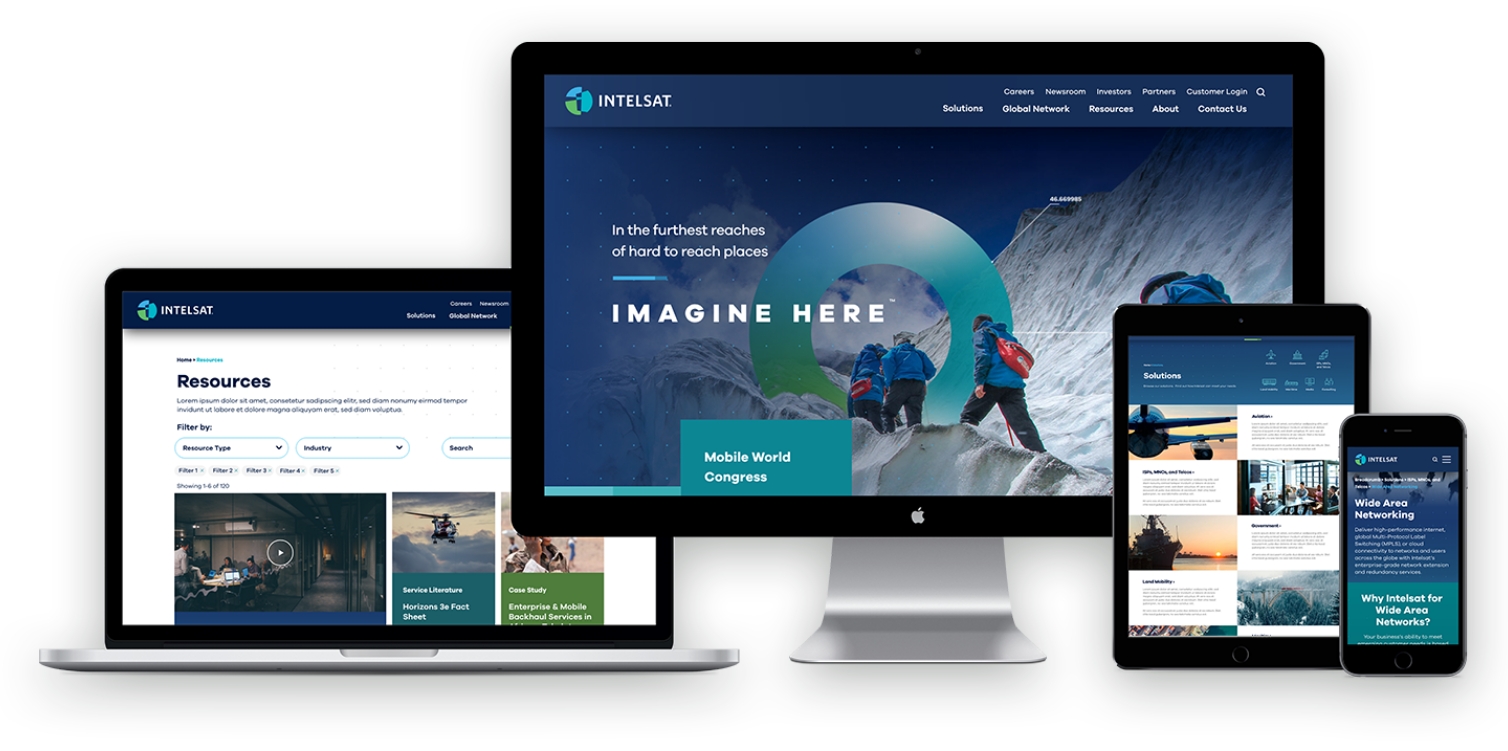

72. Keyloop Acquired Automotive Transformation Group (ATG)
Summary: UK-based automotive retail software provider Keyloop acquired Automotive Transformation Group (ATG) in May 2024. Keyloop (a Francisco Partners portfolio company, formerly part of CDK Global) offers dealer management systems (DMS) and digital solutions for car dealerships, while ATG (backed by Inflexion PE) provides an omnichannel e-commerce platform for car sales (from online reservations to showroom tools).
Strategic Advantages: The deal aims to create an integrated technology portfolio connecting the entire automotive consumer journey. By combining Keyloop’s back-end dealership software with ATG’s front-end retailing tools, the merged company can offer car manufacturers and dealers a seamless solution: from customer interest and online purchase, through financing and inventory management, to after-sales service. This meets the industry’s need for “omnichannel retailing” – consumers expect to transition smoothly between online car shopping and in-store experiences. Keyloop + ATG can facilitate things like online car configuration and pricing that flow directly into the dealer’s systems for a test drive or delivery scheduling. This streamlined customer experience can help dealerships increase sales conversions and improve customer satisfaction. Additionally, the acquisition expands Keyloop’s market share in Europe by adding ATG’s clients, and potentially allows cross-selling (Keyloop’s CRM or DMS to ATG customers, and vice versa). Efficiency-wise, integrated R&D can accelerate innovations like better data analytics for dealers.
73. Courvoisier Acquired by Campari
Summary: Italian spirits company Campari Group acquired Courvoisier, the famed French cognac brand, from Beam Suntory for €1.1B (~$1.2B) in December 2023. This was Campari’s largest deal ever, bringing one of the “big four” Cognac houses into its portfolio.
Strategic Advantages: The acquisition solidifies Campari’s push into the premium brown spirits category. Courvoisier becomes Campari’s fourth pillar (after aperitifs like Aperol, bourbon, and tequila). Strategically, it gives Campari a renowned Cognac to compete with Diageo’s Hennessy partnership and Pernod Ricard’s Martell in key markets. Immediately, it boosts Campari’s sales by ~9% and brings a spirit category (cognac) that’s seeing growth in the U.S. and China. For Campari, which previously only had a smaller cognac (Bisquit) and Grand Marnier (an orange liqueur with cognac base), acquiring Courvoisier fills a portfolio gap and diversifies its revenue. It also provides scale in the supply chain for cognac (aging stocks, production in Jarnac, etc.). Campari can leverage its global distribution to expand Courvoisier’s reach, especially in Asia-Pacific where cognac demand is strong. The brand equity of Courvoisier (associated with luxury and even pop culture) adds prestige to Campari’s lineup. CEO Kunze-Concewitz, about to retire, called it a “crowning achievement”, signaling its strategic importance. Marketing-wise, Campari can now tell a richer story of being a curator of iconic brands from bitters to cognac, appealing to premiumization trends. They might invest in Courvoisier’s branding (packaging, campaigns) as they did after acquiring Grand Marnier.


74. Axient Acquired by Astrion
Summary: Astrion, a Brightstar Capital Partners portfolio company, completed the acquisition of Axient (backed by Sagewind Capital) in September 2024. Astrion is a mission support and engineering contractor for U.S. government (recently formed, possibly combining former BRG assets), while Axient is a well-known defense and aerospace solutions provider (formed from a 2021 merger of QuantiTech, Millennium, Dynamic Concepts, etc.).
Strategic Advantages: By acquiring Axient, Astrion aims to set a new industry standard through enhanced scale and capabilities. The combined company addresses critical missions across defense and civilian agencies, spanning cybersecurity, systems engineering, space operations, and digital transformation. Essentially, Astrion + Axient creates a mid-sized powerhouse with end-to-end solutions, from R&D and testing (Axient’s forte in space and missiles) to operational mission support (Astrion’s focus). This breadth means they can bid on larger contracts and deliver more integrated offerings. For Axient’s customers (Space Force, Missile Defense, etc.), Astrion’s backing brings additional resources and capital to drive innovation – fulfilling the promise of “Accelerate Possible” that Bluetext helped brand. From Astrion’s perspective, acquiring Axient injects a large, experienced workforce (Axient had thousands of employees) and key contract vehicles, accelerating Astrion’s growth trajectory by years. The press release noted “benefits of scale” and expectation of substantial growth and exceptional outcomes. Private equity sponsors (Brightstar and Sagewind) also likely realize synergies: merging back-office functions and unifying go-to-market could improve margins.


75. Aeyon Acquired by CGI Federal
Summary: In late 2023, CGI Federal (U.S. arm of global IT firm CGI Inc.) acquired Aeyon, a rapidly growing consultancy specialized in AI, Robotic Process Automation (RPA), and financial management for U.S. federal agencies. Aeyon, backed by Enlightenment Capital, itself was formed by merging Artlin and Sehlke in 2021, with Bluetext’s help in branding (they crafted the Aeyon name and launch messaging, per their blog with CEO Sunny Singh discussing branding through M&A).
Strategic Advantages: For CGI Federal, acquiring Aeyon expands its capabilities in emerging tech and defense support services. Aeyon brings strong past performance in DoD financial management, Army robotics process automation, and Navy data analytics, complementing CGI’s traditional IT services. This helps CGI deepen relationships in national security agencies (Aeyon’s client list included defense and intelligence agencies). It also infuses entrepreneurial talent into CGI’s rather large organization – Aeyon’s leadership is known for agility and innovation. CGI cited the move as broadening its offerings in AI and automation for federal clients, aligning with government demand for digital transformation. Aeyon’s experience with the DoD’s financial systems and the JAIC’s AI initiatives can be leveraged across CGI’s wider client base. The acquisition underscores CGI’s strategy to grow via “build and buy,” adding niche expertise to bolster its federal footprint.
76. Marcum’s Non-Attest Business Acquired by CBIZ
Summary: In a major accounting industry deal, CBIZ, Inc. (a national professional services firm) acquired the non-attest business of Marcum LLP in early 2025, following Marcum’s splits from its audit practice (due to regulatory rules). This effectively merged Marcum’s tax and consulting practice into CBIZ, making CBIZ a top-10 accounting firm with 160+ offices and 10,000+ employees.
Strategic Advantages: This acquisition propelled CBIZ into the elite ranks of accounting and advisory firms. By absorbing Marcum’s advisory business, CBIZ significantly expanded its geographic reach (Marcum was strong in the Northeast and Florida) and service offerings (like capital markets advisory, specialized consulting) without conflicting with audit independence (since attest stayed separate). CBIZ can now cross-sell a broader suite of services to both client bases, e.g., offering Marcum’s consulting expertise to CBIZ’s mid-market clients and vice versa. Economies of scale in back-office functions and vendor relationships will improve margins. Importantly, the combined firm’s national presence and talent pool make it more competitive for large engagements that require depth and breadth.



77. Amelia Acquired by SoundHound
Summary: SoundHound AI, Inc., known for voice AI and speech recognition, acquired Amelia (IPsoft’s Amelia) for $80M in August 2024. Amelia is a conversational AI and digital assistant platform (originally from IPsoft) used by enterprises for customer service and IT support automation.
Strategic Advantages: This acquisition significantly expanded SoundHound’s scale and product reach in the booming conversational AI market. SoundHound primarily offered voice interface tech (e.g., for automotive and restaurants) and had gone public via SPAC in 2022. By adding Amelia, a leader in enterprise AI agents, SoundHound doubled its customer count to ~200 (including Fortune 500 companies) and projected combined 2025 revenue of $150M. It allowed SoundHound to diversify from its core voice applications into the broader digital assistant space (text-based chatbots, call center AI, etc.) – a timely move as generative AI drives demand for advanced virtual agents. Financially, paying $80M (mostly cash/equity) for a company that raised ~$189M was a bargain. SoundHound also assumed Amelia’s existing enterprise contracts (with big names like BNP Paribas and Fujitsu) and deep AI tech stack. The synergy is clear: SoundHound’s voice understanding + Amelia’s conversational workflows = next-gen AI assistants across voice and text. Post-acquisition, SoundHound could offer an end-to-end voice and chat solution, enhancing upsell opportunities. The deal also improved SoundHound’s financial outlook after a rough 2023 (stock was down, layoffs happened). With Amelia’s $45M revenue on board, SoundHound inches closer to profitability while expanding markets (IT helpdesk automation, etc.).
78. Applied Insight Acquired by CACI
Summary: Federal IT contractor CACI International acquired Applied Insight in late 2024. Applied Insight (AI LLC), backed by The Acacia Group, is a cloud and analytics firm specializing in secure cloud migration, DevSecOps, and advanced cyber for the U.S. intelligence community (IC).
Strategic Advantages: This acquisition enhanced CACI’s cloud and mission IT offerings, particularly for classified environments. Applied Insight brought its alt-cloud platform (for secure AWS/Azure in air-gapped settings) and analytics tools like SHIFT, which help simulate classified cloud setups locally – key for intel and defense clients. Integrating this, CACI can now offer full-stack enterprise IT modernization, from infrastructure to application development, with the high security the IC demands. It aligns with CACI’s strategy to invest in high-growth tech areas. Notably, Applied Insight’s work with agencies like DHS and DoD expands CACI’s customer footprint and contract vehicles. CACI’s CEO noted the combined business will “enhance cloud, cyber, and user productivity for secure networks in the IC”, indicating synergy with CACI’s existing intel support business. Financially, while terms weren’t disclosed, Applied Insight’s ~$40M+ revenue (estimate) adds to CACI’s ~$6B, so it’s a tuck-in focused on capability gains rather than scale. It also preempted competition – preventing rivals from acquiring that tech.
79. Critical Insight Acquired by Lumifi
Summary: Lumifi (formerly SilverSky), a managed detection and response (MDR) provider, acquired Critical Insight in late 2024. Critical Insight, founded by ex-CISO Mike Hamilton, offers MDR and cybersecurity-as-a-service with a strong focus on healthcare and public sector clients. This was Lumifi’s third acquisition in 13 months, following rebranding from Cygilant/SilverSky, as it aggressively consolidates the MDR market.
Strategic Advantages: The acquisition doubles down on Lumifi’s healthcare and critical infrastructure market presence. Critical Insight brings a 24/7 SOC, incident response team, and professional services that complement Lumifi’s threat monitoring and “ShieldVision” platform. Essentially, Lumifi broadens its service portfolio: adding Critical Insight’s incident response and vCISO consulting to its MDR tech stack. Geographically, Critical Insight’s West Coast roots (Seattle) and client base (hospitals, local governments) extend Lumifi’s reach. By integrating, they likely achieve some economies (shared SOC infrastructure, unified platform development) and can present a stronger value prop: full lifecycle cyber defense, from prevention to response, tailored for regulated sectors. The press release highlighted this strengthening of offerings and presence in healthcare/critical infrastructure. It’s part of Lumifi’s strategy to grow both organically and via acquisition, aiming to build enough scale to perhaps IPO or be acquired itself. Each acquisition (Infocyte, Cysiv earlier, now Critical Insight) added either technology or market share. With Critical Insight, Lumifi also gains experienced practitioners (e.g., Critical Insight’s leadership includes former government security officials) which bolsters credibility.
80. AeroVironment Acquires BlueHalo
Summary: In early 2025, defense technology leader AeroVironment acquired BlueHalo, a rapidly growing provider of advanced defense solutions spanning space, directed energy, cyber, and AI/ML-powered C5ISR systems. BlueHalo, backed by Arlington Capital Partners, had grown aggressively through acquisitions and internal R&D, carving out a leadership position in cutting-edge national security tech. AeroVironment, traditionally known for tactical UAS (unmanned aerial systems), positions this acquisition as a strategic leap into the higher end of the defense technology spectrum.
Strategic Advantages: This acquisition gives AeroVironment access to BlueHalo’s advanced capabilities in space and directed energy—domains increasingly prioritized in the Pentagon’s modernization roadmap. BlueHalo’s portfolio also includes proprietary technologies in autonomy, AI/ML, and RF engineering, which enhance AeroVironment’s offering beyond small UAS. The combined entity now covers a broader mission set: from tactical ISR and loitering munitions to space domain awareness and counter-UAS defense systems. BlueHalo’s government customer base (including key classified programs and defense R&D agencies) complements AeroVironment’s existing DoD footprint, while BlueHalo’s East Coast presence (HQ in Arlington, VA, plus facilities in Alabama, New Mexico, and Maryland) expands AeroVironment’s geographic and programmatic reach. This scale could also improve pipeline access to large IDIQs and OTA contracts.


81. Karman Space & Defense Files for IPO
Summary: In early 2025, Karman Space & Defense confidentially filed for an initial public offering, positioning itself as one of the first pure-play space and hypersonics manufacturers to seek a public listing. Formed through the combination of multiple heritage aerospace and defense suppliers—most notably AAE Aerospace, Systima Technologies, and Bal Seal Engineering—Karman has rapidly scaled into a vertically integrated supplier of mission-critical hardware for the space launch, missile defense, and hypersonic sectors. The IPO marks a milestone not just for Karman, but for the broader emergence of space-adjacent industrial players as viable public-market entities.
Strategic Advantages: Karman’s growth story is driven by consolidation, modernization, and smart positioning. By integrating legacy defense suppliers under one roof, it built a scalable manufacturing footprint tailored for the new space race—supporting both commercial launch providers and prime contractors. Its capabilities span nose cones, separation mechanisms, and propulsion-adjacent hardware—essential components for both reusable launch systems and advanced missile architectures. Karman’s competitive edge lies in its speed-to-market, vertically integrated facilities, and ability to deliver high-reliability components at production scale. With government investment in hypersonics and resilient space architectures rising sharply, Karman sits in the sweet spot: a defense-grade manufacturer that’s nimble enough to support new entrants like Rocket Lab or Firefly, but qualified enough for classified DoD and MDA programs.
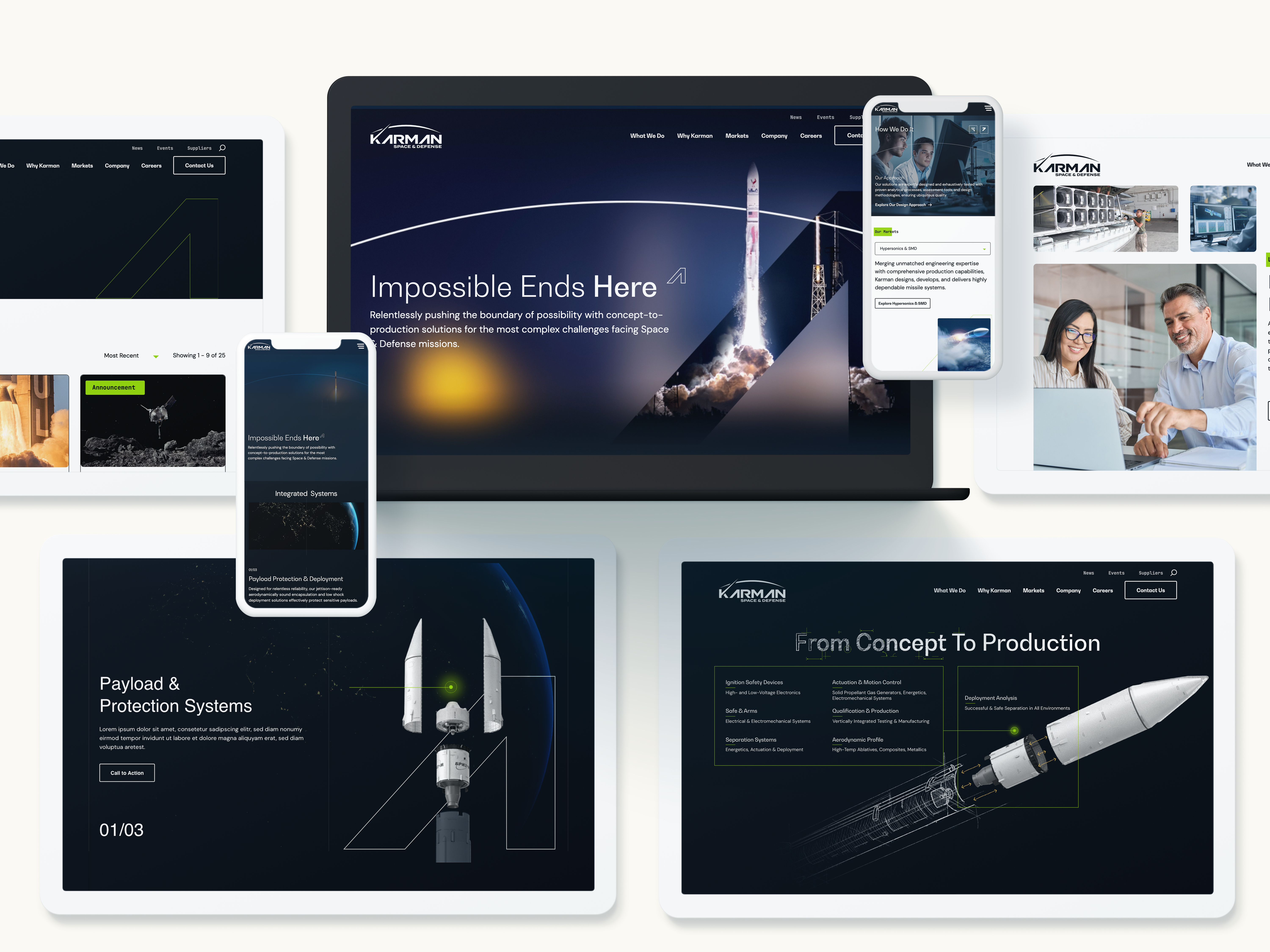


82. Anduril Acquires Klas
Summary: In early 2025, Karman Space & Defense confidentially filed for an initial public offering, positioning itself as one of the first pure-play space and hypersonics manufacturers to seek a public listing. Formed through the combination of multiple heritage aerospace and defense suppliers—most notably AAE Aerospace, Systima Technologies, and Bal Seal Engineering—Karman has rapidly scaled into a vertically integrated supplier of mission-critical hardware for the space launch, missile defense, and hypersonic sectors. The IPO marks a milestone not just for Karman, but for the broader emergence of space-adjacent industrial players as viable public-market entities.
Strategic Advantages: Karman’s growth story is driven by consolidation, modernization, and smart positioning. By integrating legacy defense suppliers under one roof, it built a scalable manufacturing footprint tailored for the new space race—supporting both commercial launch providers and prime contractors. Its capabilities span nose cones, separation mechanisms, and propulsion-adjacent hardware—essential components for both reusable launch systems and advanced missile architectures. Karman’s competitive edge lies in its speed-to-market, vertically integrated facilities, and ability to deliver high-reliability components at production scale. With government investment in hypersonics and resilient space architectures rising sharply, Karman sits in the sweet spot: a defense-grade manufacturer that’s nimble enough to support new entrants like Rocket Lab or Firefly, but qualified enough for classified DoD and MDA programs.
What’s Next: M&A as a Messaging Moment
These 82 transactions reinforce a simple truth: M&A isn’t just a financial event—it’s a brand event. It’s the moment to reset perception, redefine value, and rally internal and external audiences around a new mission. That moment, if handled correctly, can drive retention, growth, and momentum. If not, it can cause confusion, churn, and missed opportunity.
That’s where Bluetext comes in.
We’ve helped brands navigate everything from stealth-stage mergers to IPO launches, PE rollups to post-acquisition integration. If your company is planning a transaction—or needs to reposition after one—let’s talk.
Contact Bluetext to start shaping the narrative that will define your next chapter.
Government contractors face a unique digital challenge: create an experience that checks every compliance box while still connecting with users. It’s a balancing act that requires more than just meeting federal standards—it demands thoughtful, human-centered design that engages stakeholders, builds trust, and supports mission delivery.
At Bluetext, we’ve worked with leading B2G organizations to tackle this challenge head-on. Here’s what it takes to align your UX with both federal requirements and user expectations.
The UX Landscape for Government Contractors
Unlike private sector sites that prioritize conversion funnels or sleek brand storytelling, digital platforms for government contractors must often serve multiple masters. They need to be:
- Compliant with strict accessibility and data security standards
- Clear and intuitive for a wide range of users, from contracting officers to program managers
- Aligned with the mission and values of the agencies they serve
Too often, this results in dense, overly technical websites that users find difficult to navigate. But poor UX doesn’t just frustrate visitors—it can undermine credibility, reduce engagement, and even impact contract wins. Great UX isn’t a luxury in the B2G space—it’s a differentiator.



Accessibility and Compliance: The Non-Negotiables
Section 508 compliance is the baseline for any government-facing digital experience. Alongside WCAG 2.1 guidelines, these standards ensure that websites are usable by people with disabilities, including those using screen readers, keyboard navigation, or alternative input devices.
But compliance doesn’t have to be a creativity killer. In fact, designing with accessibility in mind often leads to cleaner layouts, better content structure, and more usable interfaces for everyone.
Tools like Axe, WAVE, and Lighthouse can help identify issues early in the design process. Even more important is building accessibility into your workflow from day one—writing semantic HTML, designing for contrast and readability, and testing with real users when possible.
Compliance isn’t a one-time box to check. It’s an ongoing commitment that—when done right—enhances the overall experience.
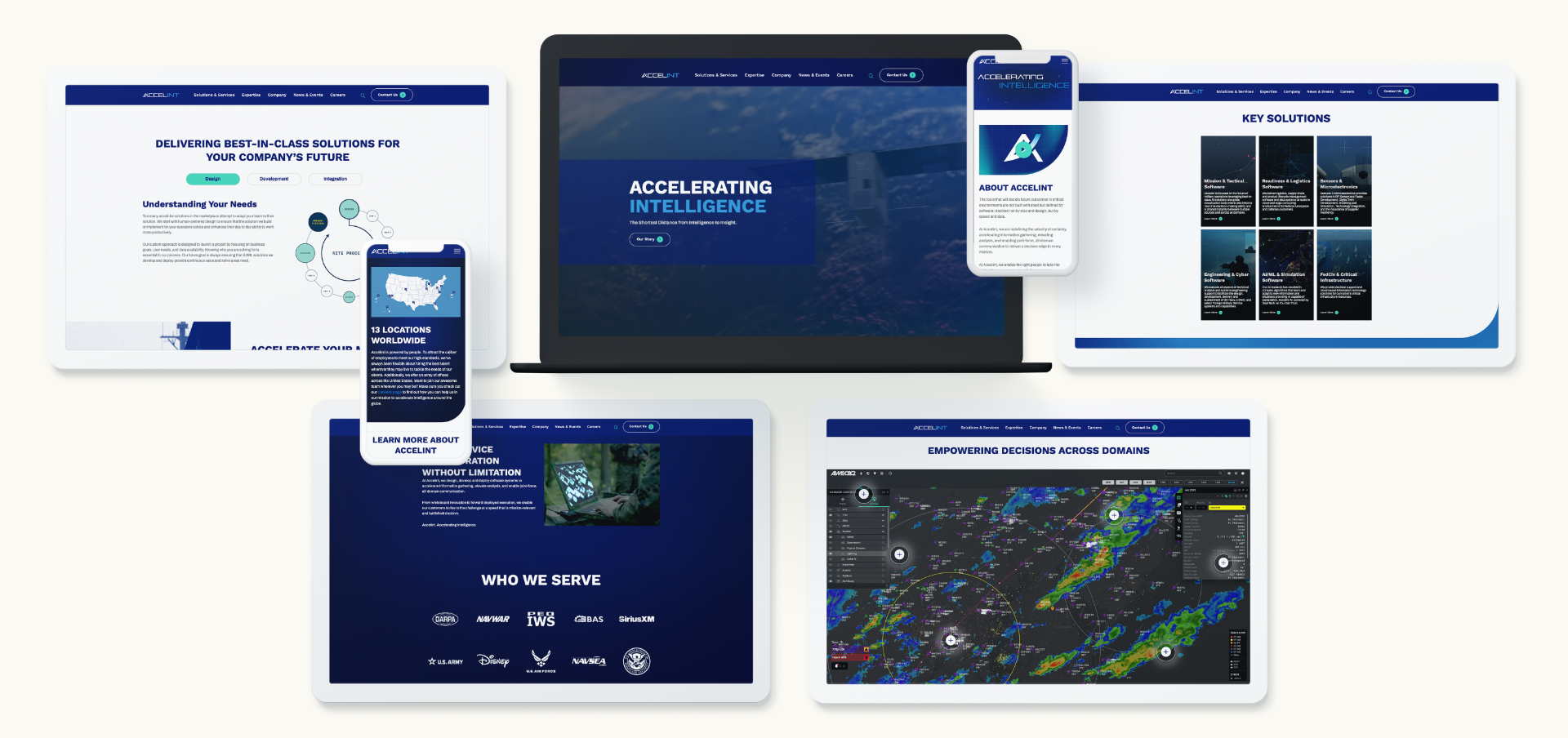

Engagement Without Compromise
Just because your site has to follow the rules doesn’t mean it has to be boring. In fact, engaging design is often about doing more with less.
Here are a few UX principles that shine in the government space:
- Clarity over cleverness: Use plain language, intuitive labels, and clear visual hierarchy.
- Consistency builds trust: Standardize layouts, navigation, and interaction patterns to reduce friction.
- Guide the user journey: Employ subtle animations, progress indicators, and calls to action to keep users oriented and informed.
Small touches—like clean iconography, digestible content blocks, or a smart search function—can go a long way in making your digital experience more intuitive and user-friendly.


Building UX into the Proposal Process
UX shouldn’t be an afterthought—or an add-on once the development process is underway. Forward-thinking government contractors are baking user experience into their RFP responses, showing prospective clients how they’ll create usable, accessible solutions from the start.
This approach demonstrates not only technical know-how, but a genuine understanding of the agency’s end users and mission. By collaborating across design, development, content, and compliance teams early, contractors can avoid costly rework and deliver smarter, faster solutions.
Future Trends in Gov UX
The bar is rising for digital experiences—even in the public sector. Government buyers and stakeholders increasingly expect:
- Mobile-first functionality that works seamlessly across devices
- AI-enhanced interfaces for smarter content delivery and navigation
- Modular, design system-driven platforms that allow for scalable updates and consistency
- Human-centered cybersecurity, where secure doesn’t mean confusing
As these expectations evolve, the ability to deliver UX that’s both compliant and compelling will become a critical differentiator.
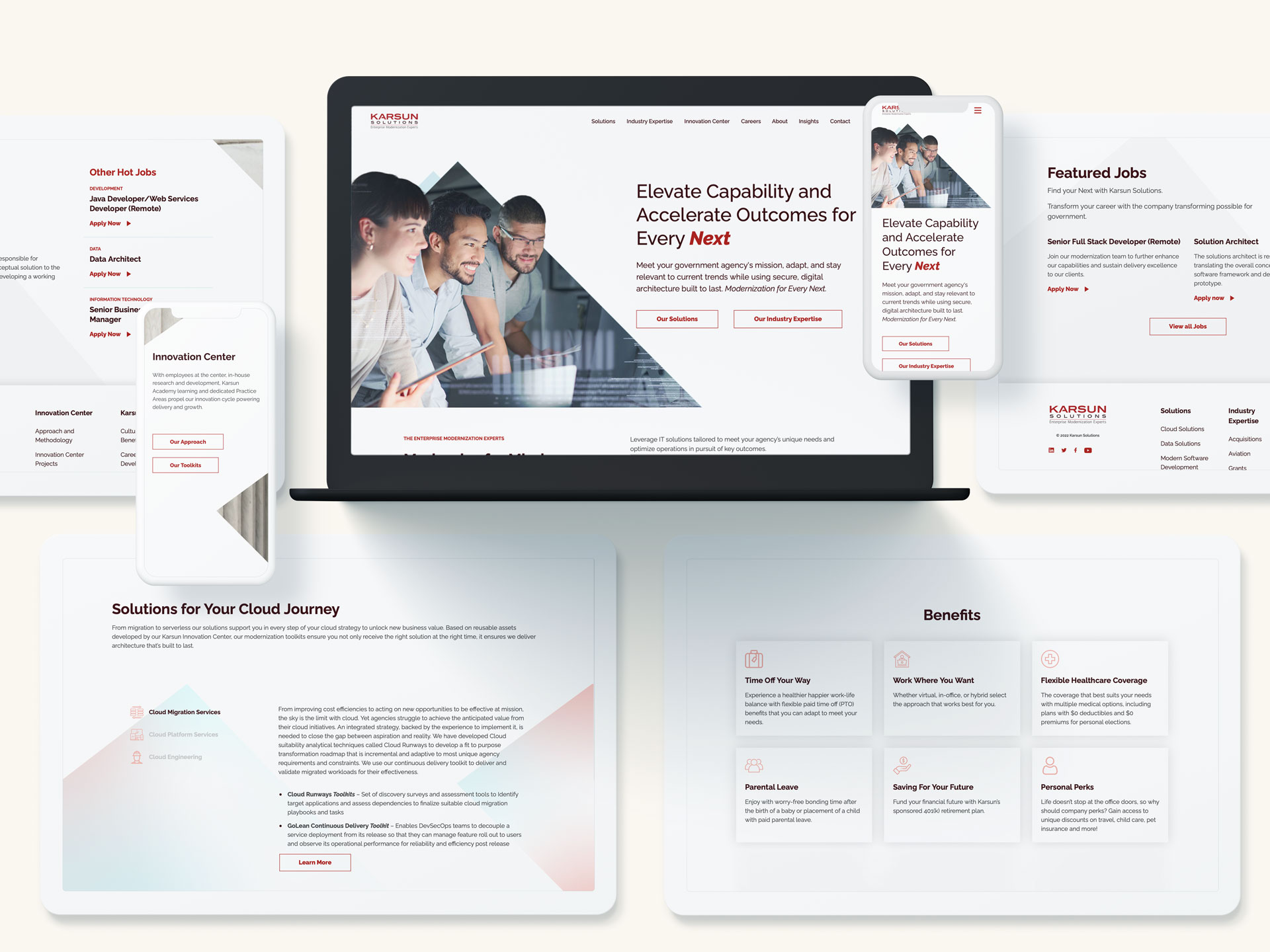

Partnering with Experts for Results
Designing UX for the government audience requires more than a basic understanding of Section 508. It requires an agency partner that understands the nuances of federal requirements, the strategic goals of B2G marketing, and the creative potential of great design.
At Bluetext, we specialize in creating digital experiences that meet the highest standards for accessibility and engagement—whether you’re responding to an RFP, redesigning a contractor portal, or launching a campaign microsite.
Is your digital presence working as hard as your proposal team? Contact Bluetext to build a UX that’s as smart, secure, and strategic as your business.